Electric vehicle sales continue to grow in Australia and the choice of vehicles in the SUV category has grown considerably.
SUVs continue to lead the charge when it comes to electric vehicle (EV) sales in Australia.
Not at the rate experienced earlier this decade, but demand for them is still at record levels, with the 100,000 annual sales mark set to be breached for the first time this year.
Below you'll find a complete list of all the EV SUV choices available to buyers right now in Australia, organised into small, mid-size and large SUVs, from the lowest to the highest price in each category.
For this guide, we’re quoting the industry-standard 10-80 per cent 50kW DC fast recharge data and the 0-100 per cent data for 7kW Wallbox and 2.3kW home-plug AC charging.
Skip to Mid-sized electric SUVs »
Skip to Large electric SUVs »
SMALL SUVs
MG ZS EV from $39,990 driveaway
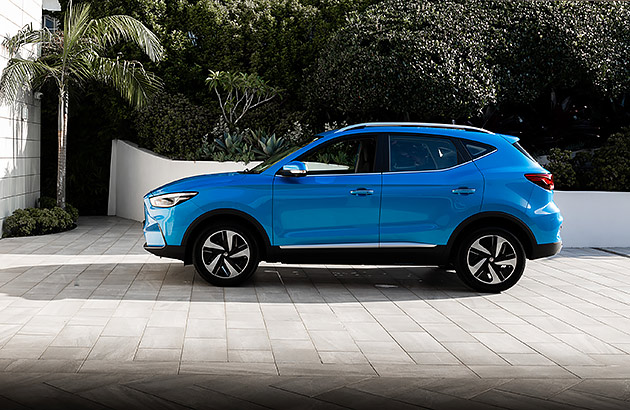
The ZS EV from China remains one of Australia’s oldest – and cheapest – EVs.
An extended-range flagship version, called Long Range (LR), arrived in 2023. It adds a 72kWh battery offering a handy 440km of range. This compares to 320km for the continuing 50.3kWh Standard Range (SR) version.
To charge the latter with a 50kW DC charger to 80 per cent, you’ll need about 70 minutes (SR: 62min), while a 7kW Wallbox at home/work requires around 12 hours to reach 100 per cent full (SR: 9hr), as opposed to nearly 40 hours using a household plug (SR: 25hr).
Both ZS EVs are roomy and well equipped, and offer strong performance from a 130kW electric motor. But while the MG corners precisely, the suspension can feel jittery and there’s not much refinement.
Note that MG often slashes pricing for limited periods to stimulate sales – a sure sign the ZS is nearing its demise.
| Motor: | Synchronous electric permanent-magnet |
|---|---|
| Transmission/drive: | Single-speed reduction gear/FWD |
| Battery: | 51kWh and 72kWh Lithium Iron Phosphate |
| Power/torque: | 130kW/280Nm |
| 0-100km/h: | 8.6s / 8.4s) |
| Consumption: | 17.3, 17.8kWh/100km |
| Electric range: | 320km / 440km |
| Warranty: | 10yr/250,000km |
| Battery warranty: | 10yr/unlimited km |
| Safety rating: | 5 stars |
Chery Omoda E5 from $42,990
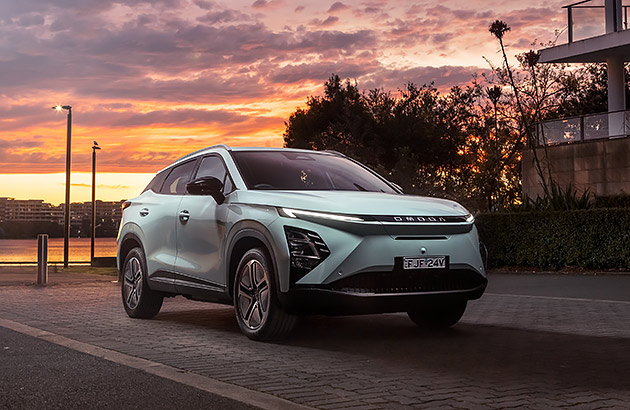
Launched in Australia in late 2024, the Omoda E5 is an EV version of the cheap Omoda 5 petrol crossover from China.
Two well-equipped grades are currently available to help justify a much-higher price point than the ICE versions, with both offering a front-mounted electric motor driving the front-wheels.
Zippy performance makes the E5 far more pleasant than the petrol equivalent, and the suspension is slightly less stiff and bouncy. A nicely-presented interior is another bonus.
But the boot is small, the infuriating driver-assist calibrations need Australian-road tuning, and the Chery is up against some very strong competition from other EVs.
Topping the 64kWh battery up from 10-80 per cent at a 50kW DC charger requires almost 70 minutes, while plugging at home to 100 per cent can take up to 32 hours, or 10hrs using an optional 7kW Wallbox.
As an inexpensive crossover EV, the Omoda E5 has some merit, but it’s also far from the best.
| Motor: | Synchronous electric permanent-magnet |
|---|---|
| Transmission/drive: | Single-speed reduction gear/FWD |
| Battery: | 64kWh Lithium Iron Phosphate |
| Power/torque: | 150kW/340Nm |
| 0-100km/h: | 7.6s |
| Consumption: | 15.5kWh/100km |
| Electric range: | 430km |
| Warranty: | 7yr/unlimited km |
| Battery warranty: | 8yr/160,000km |
| Safety rating: | 5 stars |
BYD Atto 3 from $44,499
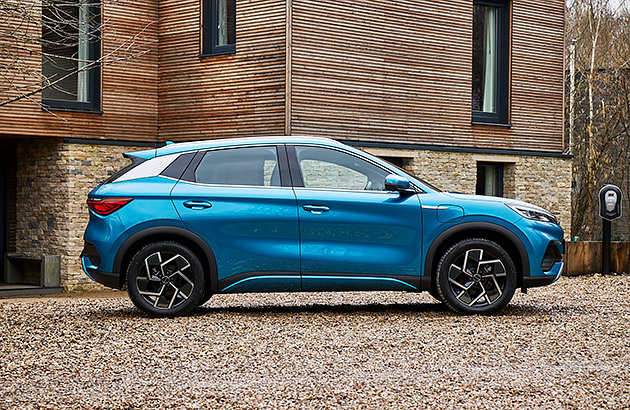
BYD – for Build Your Dreams – is a Chinese car company created in 2003, with the Atto 3 its first big hit.
Like the MG ZS, the BYD is a small SUV offering a high-riding five-seater body style. It also features a futuristically-designed dashboard, plenty of space all-round and decent equipment levels, including a long list of driver-assist safety gear.
For 2024, a lower entry price and raft of minor changes were added, including a larger rotating central touchscreen, wireless Apple CarPlay and car-off air-conditioning.
Built on a dedicated EV platform, the Atto 3 employs a 150kW electric motor and front-wheel drive. The Standard Range offers 345km of range while the Extended Range boosts that to 420km.
Using a 50kW DC charger, an 80 per cent top-up needs about 60 minutes, over 30 hours to 100 per cent full plugged into a household socket or about 10 hours via an optional 7kW Wallbox.
| Motor: | Synchronous electric permanent-magnet |
|---|---|
| Transmission/drive: | Single-speed reduction gear/FWD |
| Battery: | 49.9/60.5kWh Lithium Iron Phosphate |
| Power/torque: | 150kW/310Nm |
| 0-100km/h: | 7.9s / 7.3s |
| Consumption: | 15.6kWh/100km |
| Electric range: | 345/420km |
| Warranty: | 7yr/150,000km |
| Battery warranty: | 8yr/160,000km |
| Safety rating: | 5 stars |
RELATED:
- Best Electric Cars coming to Australia in 2025 »
- Electric Cars available in Australia »
- Small Electric Cars available in Australia »
- Electric Vans available in Australia »
- Electric and Hybrid Utes available in Australia »
Jeep Avenger from $49,990
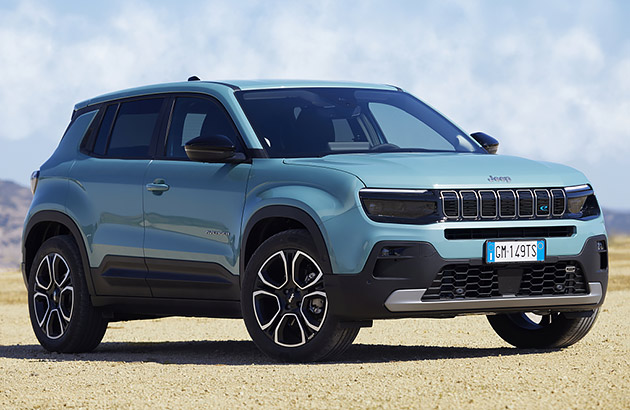
Though undeniably a Jeep visually, the Avenger is yet another EV based on the Common Modular Platform from parent company, Stellantis, and is closely related to the Peugeot e-2008. It’s even made in Europe.
But as the first electric Jeep as well as the most urban, the front-wheel-drive-only Avenger EV promises some (light) off-road capability, thanks to its chunky styling, short overhangs and high ground clearance.
In fact, the small SUV’s user-friendly interior, decent on-road dynamics and efficiency-enhancing lightness (for an EV) helped snare it a European Car of the Year award in 2023.
The 54kWh battery needs just over a day to recharge using a household plug or eight hours with an optional 7kW Wallbox, while a 50kW DC charger will take it to 80 per cent within an hour.
As progressive as the brand-defining Wrangler is traditional, the keenly priced Avenger is adventurous enough to usher in newer and younger buyers to the fold.
| Motor: | Synchronous electric permanent-magnet |
|---|---|
| Transmission/drive: | Single-speed reduction gear/FWD or AWD |
| Battery: | 54kWh Nickel Manganese Cobalt |
| Power/torque: | 115kW/260Nm |
| 0-100km/h: | 9.0s |
| Consumption: | 15.6kWh/100km |
| Electric range: | 396km |
| Warranty: | 6yr/150,000km |
| Battery warranty: | 8yr/160,000km |
| Safety rating: | 3 stars |
Hyundai Kona Electric from $54,000
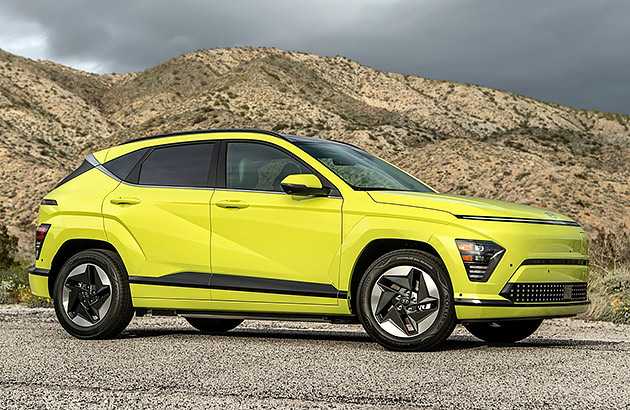
The original Kona was quite a compact SUV; its eye-catching successor is larger and roomier, as well as more practical, to boot.
Related to the Kia Niro II, the Kona II Electric isn’t as advanced as Hyundai’s acclaimed Ioniq 5/6 models, as it is built on a flexible platform supporting petrol engines as well as EVs, but nor is it as expensive, either.
The 114kW Standard Range (SR) features a 51kWh battery with a 342km range, while the 160kW Long Range (LR) gains a 65.4kWh battery for up to 490km between top-ups.
Speaking of which, with the LR, a 10 to 80 per cent refill using a 50kW DC fast charger requires about 75 minutes, 11 hours with an optional 7kW Wallbox or about 34 hours plugged in at home. Deduct about 25 per cent for the SR.
A ‘Vehicle-2-Load’ facility means owners can also power electrical appliances with their EV if required, further highlighting the Kona's newfound functionality.
| Motor: | Synchronous electric permanent-magnet |
|---|---|
| Transmission/drive: | Single-speed reduction gear/FWD |
| Battery: | 51kWh/65.4kWh Lithium Ion |
| Power/torque: | 114kW/255Nm or 160kW/255Nm |
| 0-100km/h: | 8.8s/7.8s |
| Consumption: | 14.6kWh/100km |
| Electric range: | 370km/505km |
| Warranty: | 5yr/unlimited km |
| Battery warranty: | 8yr/160,000km |
| Safety rating: | N/A |
Xpeng G6 from $54,800

Founded in 2014, Xpeng is a Chinese start-up with big high-tech multi-national backers and ever bigger ambitions.
Orderable online, the G6 is a pleasantly-styled small-to-medium-sized SUV/crossover, boasting plenty of space, a sizeable boot and lots of equipment for the money. The latter includes phone-as-key functionality, a panoramic glass roof and heated outboard seating.
Joining an elite group of EVs, the G6 uses an 800-volt EV architecture designed for fast charging, and also offers the ability to charge external appliances.
An electric motor is mounted out back and drives the rear wheels, providing strong, smooth performance.
Two battery sizes are available – a Standard Range and Long Range.
Charging the 69kWh battery using a 50kW DC charger requires up to 60 minutes for an 80 per cent refill (92kWh: 90mins), or 34 hours plugged in at home/work (92kWh: 45hrs) and 10.5hrs with an optional 7kW
Wallbox (92kWh: 14hrs) for a full top-up.
The Xpeng G6 provides formidable competition to its Tesla Model Y rival.
| Motor: | Synchronous electric permanent-magnet |
|---|---|
| Transmission/drive: | Single-speed reduction gear/RWD |
| Battery: | 69kWh, 92kWh Lithium Ion |
| Power/torque: | 190kW/440Nm, 210kW/440Nm |
| 0-100km/h: | 5.6s, 6.7s |
| Consumption: | 17.5kWh |
| Electric range: | 435km, 550km-570km |
| Warranty: | 5yr/120,000km |
| Battery warranty: | 8yr/160,000km |
| Safety rating: | 5 stars |
Smart #1 from $54,900
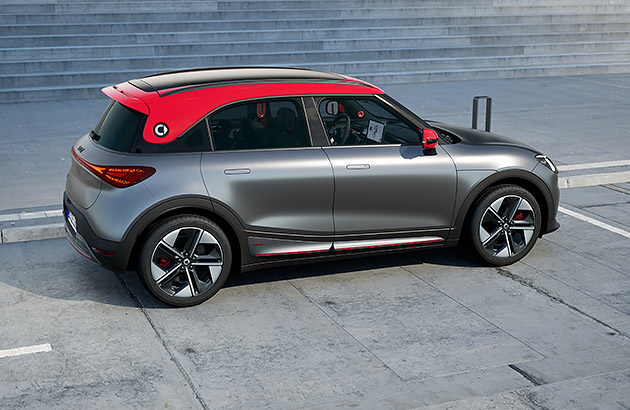
Smart returned to Australia after a decade’s absence in 2024 with the #1.
This is a small crossover aimed at the Mini Aceman. Made in China, it is a co-op between Mercedes and Geely. Its SEA platform is shared with some Volvo and Polestar EVs.
Spacious thanks to clever packaging, there’s little to criticise inside the pleasant cabin bar the glass roof with no sun cover.
The Smart comes in three well-equipped grades. The lower two use a rear-mounted electric motor driving the rear wheels, while the racy Brabus adds another up front for all-wheel drive.
Both are spirited performers, but the Brabus can be blisteringly quick. The steering is light and the suspension compliant, but the driver-assist warnings are overly sensitive.
To top the battery to 80 per cent at a 50kW DC charger can take up to 65 minutes, or 32 hours and 10hrs to 100 per cent plugged in either at home or using an optional 7kW Wallbox respectively.
| Motor: | Synchronous electric permanent-magnet |
|---|---|
| Transmission/drive: | Single-speed reduction gear/RWD, AWD |
| Battery: | 66kWh Lithium Ion |
| Power/torque: | 200kW/343Nm, 315kW/543Nm |
| 0-100km/h: | 6.7s, 3.9 |
| Consumption: | 16.7-17.0kWh, 17.9kWh/100km |
| Electric range: | 420-440km, 400km |
| Warranty: | 5yr/150,000km |
| Battery warranty: | 8yr/160,000km |
| Safety rating: | 5 stars |
Renault Megane E-Tech from $54,990
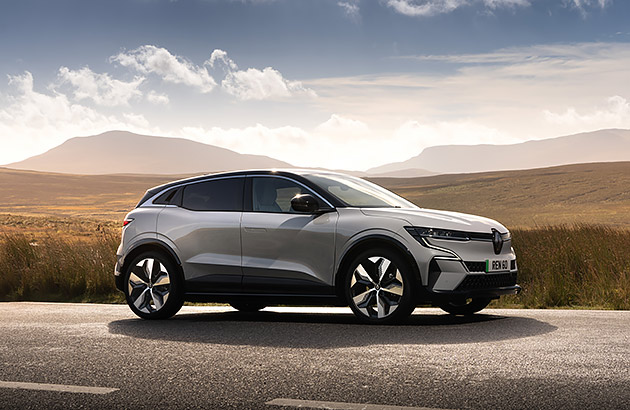
One of the most advanced and exciting new-wave EVs, the Megane E-Tech is a midsized SUV designed to take on the Hyundai Ioniq 5.
Available as a single, highly-specified model, brandishing handsome proportions and a spacious and contemporary five-seater interior that prioritises recyclable materials.
On that subject, power is provided by a 160kW motor that avoids rare-earth elements, driving the front wheels, while a 60kWh provides a highly-impressive 450km range.
Renault says it prioritised sporty performance and agility, yet has also worked hard to make the Megane E-Tech plush and refined in the old-school French-car manner.
A 50kW DC charger needs about 60 minutes for a 10 to 80 per cent battery top-up. With the included 7kW Wallbox count on around 10 hours, or nearly 31 hours using a regular socket, for a 100 per cent refill.
Rapid, sophisticated and inviting, the Megane E-Tech is a leading EV contender. And now, it’s more-keenly priced too.
| Motor: | Synchronous electric permanent-magnet |
|---|---|
| Transmission/drive: | Single-speed reduction gear/FWD |
| Battery: | 60kWh Lithium Ion |
| Power/torque: | 160kW/300Nm |
| 0-100km/h: | 7.4s |
| Consumption: |
16.1kWh/100km |
| Electric range: | 454km |
| Warranty: | 7yr/unlimited |
| Battery warranty: | 8yr/160,000km |
| Safety rating: | 5 stars |
Mini Aceman from $55,990
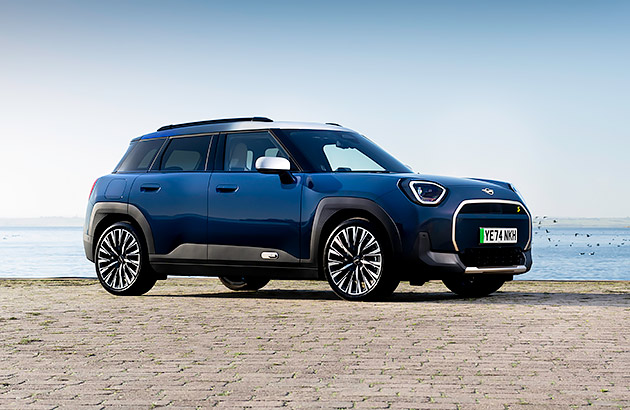
Based on the latest Mini Cooper Electric that sits on an all-EV architecture co-developed with China’s GWM, BMW’s Mini Aceman is the raised crossover version, slotting under the larger Countryman SUV.
With five doors, five seats and a modest boot, the Aceman lands in two model choices – the E and more-powerful SE.
The roomy interior again features a large, brilliant, central, round OLED touchscreen that takes care of most of the controls. Minimal in execution yet endlessly configurable, it feels both stylishly nostalgic yet ultra-modern.
The front-mounted electric motor drives the front wheels, providing eager acceleration, on-brand fun handling and lots of grip. The SE brings a larger battery for extended range.
Charging at home, the E needs 20 hours to fully replenish from empty; using an optional 7kW Wallbox cuts that to just over 6hrs while a 50kW DC charger requires 45 minutes for a 10-80 per cent refill. The SE’s corresponding figures are 25hrs, 8hrs and 55mins.
| Motor: | Synchronous electric permanent-magnet |
|---|---|
| Transmission/drive: | Single-speed reduction gear/FWD |
| Battery: | 42.5kWh and 54kWh Lithium Ion |
| Power/torque: | 135kW/290Nm, 160kW/330Nm |
| 0-100km/h: | 7.9s, 7.1s |
| Consumption: |
14.1kWh, 14.8kWh/100km |
| Electric range: | 310km, 406km |
| Warranty: | 5yr/ unlimited km |
| Battery warranty: | 8yr/160,000km |
| Safety rating: | N/A |
Zeekr X from $56,900
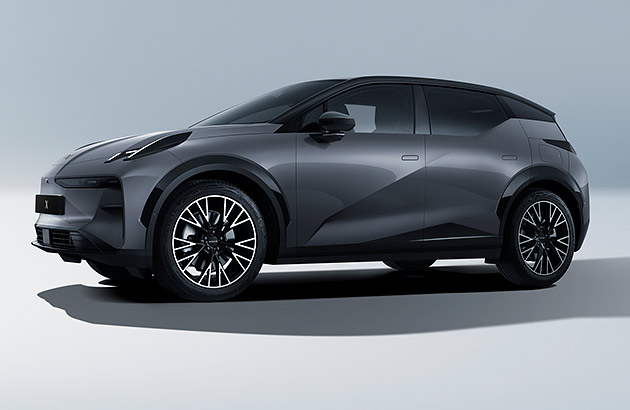
Volvo and Polestar owner Geely of China has introduced another brand in Australia, called Zeekr, and its first model is the X.
Using the same SEA2 platform as the Volvo EX30 and Smart #1/#3 twins, the angular, stubby small SUV undercuts both in price.
Highly specified and nicely presented, the X’s interior is minimalist, but feels solid and contemporary, with a large central touchscreen. Space is OK for a small SUV up front, tight in the back seat and the boot is small.
Zeekr offers two powertrain choices – a single-motor rear-drive and dual-motor all-wheel drive. There’s plenty of power, and the ride is comfy, but some reviews have complained about overly-sensitive driver-assist safety systems.
Using a 50kW DC charger can take up to 60 minutes for an 80 per cent top-up, or 33 hours plugged in at home/work and 10.5hrs with an optional 7kW Wallbox for a 100 per cent fill.
Distinctive design and keen pricing help the Zeekr X stand out of the crowd.
| Motor: | Synchronous electric permanent-magnet (rear), asynchronous (front) |
|---|---|
| Transmission/drive: | Single-speed reduction gear/RWD, AWD |
| Battery: | 66kWh Lithium Ion |
| Power/torque: | 200kW/343Nm, 315kW/543Nm |
| 0-100km/h: | 5.6s, 3.8s |
| Consumption: |
16.4kWh, 18.3kWh/100km |
| Electric range: | 540km, 470km |
| Warranty: | 5yr/ unlimited km |
| Battery warranty: | 8yr/160,000km |
| Safety rating: | 5 stars |
Smart #3 from $57,900
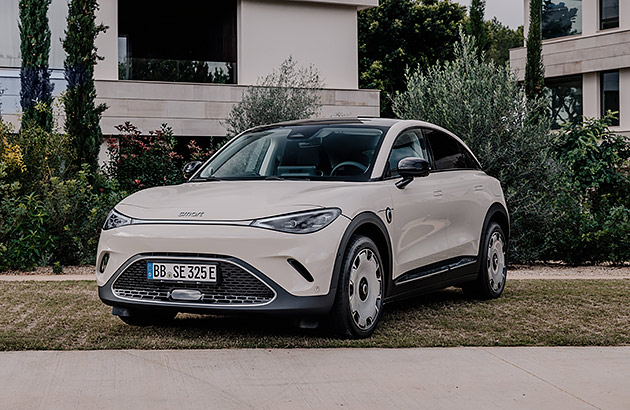
A sleeker, coupe-SUV version of the Smart #1, the swoopy #3 boasts a longer wheelbase and stronger performance. Made in China, it shares a platform with some Volvo, Polestar and Zeekr models.
There’s a Mercedes GLA-esque vibe inside, with quality materials and finishes, along with decent practicality. But having a glass roof with no sun cover is an oversight in hot Australia.
Of the three variants, only the sporty Brabus eschews the rear-motor/rear-drive set-up for a dual-motor all-wheel drive configuration, which helps tame its considerable performance. Easy steering and a comfy ride are further bonuses, though the driver-assist tech is far-too reactive and annoying.
As with the #1, the #3’s 66kWh battery needs up to 65 minutes for an 80 per cent top-up at a 50kW DC charger, or 32 hours using a home plug and 10hrs with an optional 7kW Wallbox for a 100 per cent refill.
Eager, easy and efficient, the #3 is a charming surprise.
| Motor: | Synchronous electric permanent-magnet |
|---|---|
| Transmission/drive: | Single-speed reduction gear/RWD, AWD |
| Battery: | 66kWh Lithium Ion |
| Power/torque: | 200kW/343Nm, 315kW/543Nm |
| 0-100km/h: | 5.8s, 3.7 |
| Consumption: |
16.3-16.8kWh, 17.6kWh/100km |
| Electric range: | 435-455km, 415km |
| Warranty: | 5yr/150,000km |
| Battery warranty: | 8yr/160,000km |
| Safety rating: | 5 stars |
Volvo EX30 from $59,990
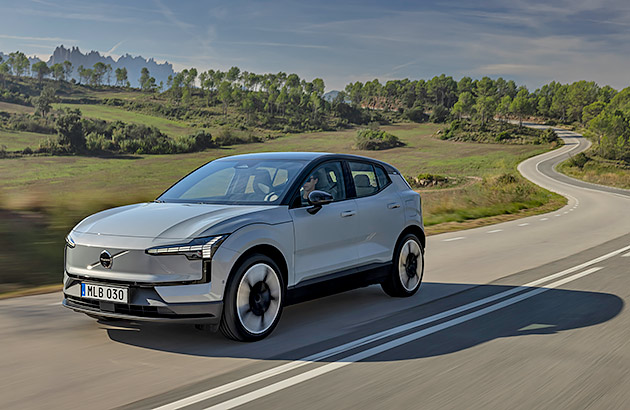
There’s never been a Volvo like it. Barely bigger than Mazda CX-3, the EX30 EV is a youthful, urban-focused crossover aimed at luring new customers to the Swedish brand.
Built in China and sharing its architecture with models with parent company Geely’s portfolio, the five-seater EX30 is offered in single-motor rear-drive and twin-motor all-wheel drive configurations. Dubbed Twin Motor Performance, the latter is the fastest-accelerating Volvo ever.
A 50kW outlet requires about an hour for an 80 per cent fill, while an optional 7kW Wallbox requires a bit over 10 hours, compared to 33 plugged into a normal socket.
Influenced by Tesla, the EX30’s pared-back designer interior is dominated by a centrally-located touchscreen that can be frustrating to use, so it definitely requires some familiarisation. Front-seat comfort and space are fine, but the rear bench is cramped for adults.
Cute, dynamic, fun and ridiculously fast, this is not the Volvo family truckster from yesteryear.
Later in 2024 the e-2008 facelift is coming, with more power and usefully more range, but it will probably cost a lot more, too.
| Motor: | Synchronous electric permanent-magnet |
|---|---|
| Transmission/drive: | Single-speed reduction gear/RWD, AWD |
| Battery: | 69kWh Lithium Ion |
| Power/torque: | 200kW/343Nm, 315kW/543Nm |
| 0-100km/h: | 5.3s, 3.6s |
| Consumption: | 15.7, 16.3kWh/100km |
| Electric range: | 480km / 460km |
| Warranty: | 5yr/unlimited km |
| Battery warranty: | 8yr/160,000km |
| Safety rating: | N/A |
Peugeot e-2008 from $59,990
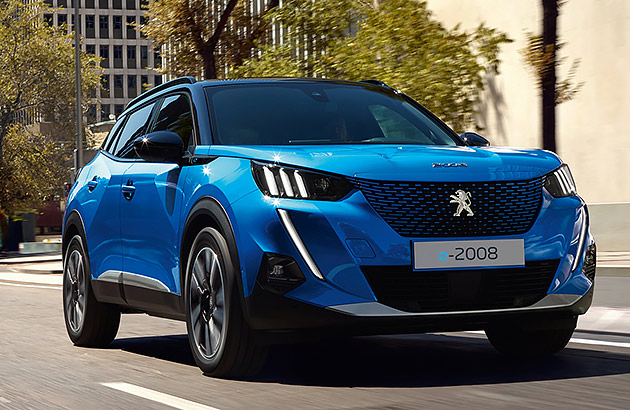
Peugeot’s first EV for Australia is also one of Europe’s bestsellers, having been available there since 2021.
The e-2008 is based on the brand’s stylish petrol-powered 2008 small SUV, with its crisp lines and progressive and surprisingly upmarket interior presentation, and aims to steal sales from more-expensive luxury EV crossovers like the Mercedes EQA and BMW iX1.
Under the bonnet is a 100kW electric motor, driving the front wheels, with a modest 50kW battery providing a maximum 328km of range. This is a city-focused Euro SUV, after all.
Topping that battery up from 10-80 per cent using a 50kW DC public charger only needs about 45 minutes, or roughly eight hours to 100 per cent with an optional 7kW Wallbox and about 24 hours via a household plug.
Peugeot has enough stock for the pre-facelift e-2008 to spill into 2025. Once these deplete, it will likely pass on the MY25 EV version and instead concentrate on the 2008 petrol-electric Hybrid instead.
| Motor: | Synchronous electric permanent-magnet |
|---|---|
| Transmission/drive: | Single-speed reduction gear/FWD |
| Battery: | 50kWh Lithium Ion |
| Power/torque: | 100kW/260Nm |
| 0-100km/h: | 8.5s |
| Consumption: | 15.7 kWh/100km |
| Electric range: | 328km |
| Warranty: | 5yr/unlimited km |
| Battery warranty: | 8yr/160,000km |
| Safety rating: | 5 stars |
Mini Countryman Electric from $64,990
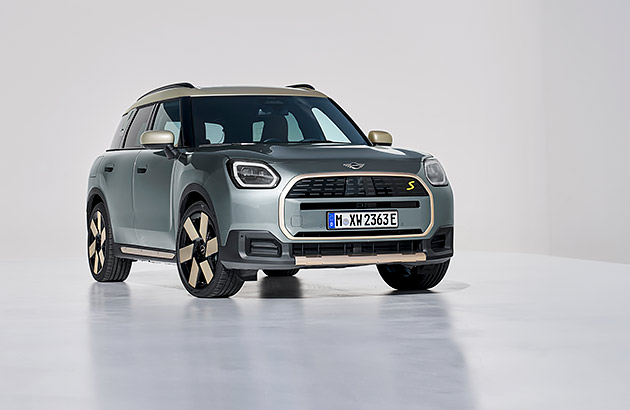
Sharing much with the BMW X1/X2 twins underneath, the German-built third-generation Countryman is the largest Mini in history, and considerably bigger than preceding versions.
It’s also the first with an all-electric powertrain option, sharing the BMW iX1/iX2 architecture that brings the option of the single-motor front-drive E and twin-motor all-wheel drive SE versions. The latter promises racy performance, though – being a BMW-based Mini – there’s plenty of driving enjoyment engineered into the not-so-small SUV’s DNA.
Along with a modern, spacious and practical interior, another Countryman highlight is the brilliant OLED touchscreen display, pushing boundaries for response, clarity, functionality and ease. There’s also a freshness to the textures and materials that make up the cabin.
Using a 50kW DC charger, an 80 per cent top-up needs about 75 minutes, 11 hours with a 7kW Wallbox or around 33 hours with a regular socket.
Quirky yet smartly packaged, the electric Countryman stands out amongst EV SUVs.
| Motor: | Synchronous electric permanent-magnet |
|---|---|
| Transmission/drive: | Single-speed reduction gear/RWD, AWD |
| Battery: | 64.7kWh Lithium Ion |
| Power/torque: | 150kW/250Nm, 230kW/494Nm |
| 0-100km/h: | 8.6s, 5.6s |
| Consumption: | 14.0, 14.9kWh/100km |
| Electric range: | 462km, 432km |
| Warranty: | 5yr/unlimited km |
| Battery warranty: | 8yr/160,000km |
| Safety rating: | N/A |
Kia Niro II EV from $66,590
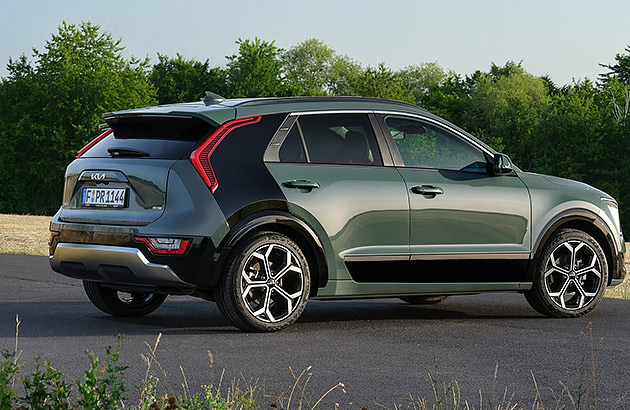
Twinned with the second-generation Hyundai Kona II, the Niro II builds on its homely predecessor’s family-friendly crossover shape with more space and practicality, as well as a far-more modern dash, with a massive touchscreen look.
Like the Hyundai, the Kia is again available in petrol and hybrid guises, meaning it doesn’t employ the Hyundai Group’s vaunted new E-GMP EV architecture, but an updated “EV-first” version of the old platform.
As before, a 150kW electric motor drives the front wheels. Range is an impressive 463km.
Plugging the Kia in a household socket needs nearly 34 hours to replenish the 64.8kWh battery; an optional 7kW Wallbox will slash that to about 11 hours, while a 50kW DC public fast charger will take it from 10 to 80 per cent full in around 70 minutes.
Easy, spacious and comfortable, but now with fresher styling, more advanced driver-assist safety and improved efficiency, the Niro EV deserves a good, hard look.
| Motor: | Synchronous electric permanent-magnet |
|---|---|
| Transmission/drive: | Single-speed reduction gear/FWD |
| Battery: | 64.8kWh Lithium Ion |
| Power/torque: | 150kW/255Nm |
| 0-100km/h: | 7.8s |
| Consumption: | 16.4kWh/100km |
| Electric range: | 463km |
| Warranty: | 7yr/unlimited km |
| Battery warranty: | 8yr/160,000km |
| Safety rating: | 5 stars |
Polestar 2 from $62,400
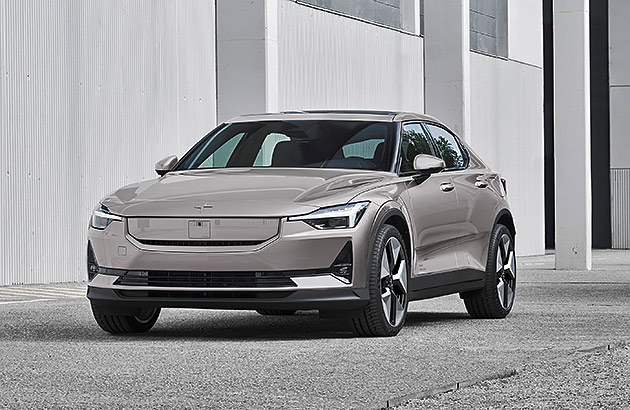
Volvo’s in-house EV performance brand has had a strong start with the Polestar 2 – a handsome high-riding five-door hatchback/crossover aimed at Tesla’s Model 3.
The original 170kW single-motor (SM) front-drive and 300kW twin-motor (TM) all-wheel drive EV series gave way to a substantially changed product.
The Polestar 2 SM Series 2 swaps to rear-drive – just like the related latest Volvo XC40/C40 twins – while all models gain revised motors (SM: 220kW, TM: 310kW), better efficiency, stronger performance, longer range, faster charging, improved suspension and updated safety.
A 69kWh battery is all-new, along with an optional 82kWh long-range (LR) battery.
A 50kW DC public outlet will charge either battery sizes from 10-80 per cent in about 70 minutes, or to 100 per cent in 11 hours with an optional 7kW Wallbox and 35hr using a household plug (LR is 13hr and 40hr respectively).
Beautifully executed and with quality (vegan) materials, the Polestar 2 Series 2 is more compelling than ever.
| Motor: | Synchronous electric permanent-magnet |
|---|---|
| Transmission/drive: | Single-speed reduction gear/RWD or AWD |
| Battery: | 69kWh, 82kWh (LR), Lithium Ion |
| Power/torque: | 200kW/490Nm, 220kW/490Nm, 310kW/740Nm |
| 0-100km/h: | 6.4s, 6.2s, 4.5s (4.2s with 350kW Perf. Pack) |
| Consumption: | 16.5 to 19.5kWh/100km (estimated) |
| Electric range: | 532km, 654km, 591km |
| Warranty: | 5yr/unlimited |
| Battery warranty: | 8yr/160,000km |
| Safety rating: | 5 stars |
Volkswagen ID.4 from $70,000 (estimated)
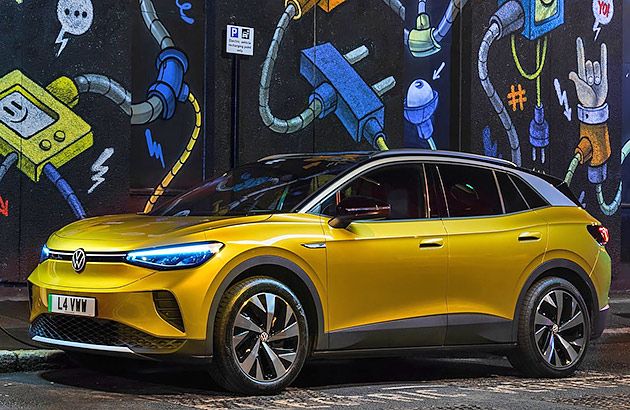
Expected before mid-2025, the endlessly delayed and now aging ID.4 is a medium-sized crossover/SUV to rival the Toyota bZX4.
The brand’s first EV in Australia, sat on a dedicated EV platform, it is a solid if conservative design inside and out, but with plenty of space and lots of practicality.
We’re anticipating a 125kW rear-mounted motor version driving the rear wheels, and motivated by a 55kWh battery for a 345km range. There’s also a 150kW model that’s powered by an 82kWh battery for a range of 522km.
Whether we see the dual-motor models with all-wheel drive remains to be seen.
With the 55kWh battery, a 50kW DC charger means a 10 to 80 per cent wait time of about 60 minutes (82kWh battery: 75min), nine hours with an optional 7kW Wallbox (82kWh: 12hr) and about 27 hours using in household socket (82kWh: 40hr).
Said to be unexciting but competent to drive, the ID.4 should be a sensible option.
| Motor: | Synchronous electric permanent-magnet |
|---|---|
| Transmission/drive: | Single-speed reduction gear/RWD |
| Battery: | 55kWh and 82kWh Lithium Ion |
| Power/torque: | 125kW/310Nm and 150kW/310Nmm |
| 0-100km/h: | 9.0s and 8.5s |
| Consumption: | 16.7 and 17.2kWh/100km |
| Electric range: | 345km and 522km |
| Warranty: | 5yr/unlimited km |
| Battery warranty: | 8yr/160,000km |
| Safety rating: | 5 stars |
Volvo XC40 Recharge from $76,990
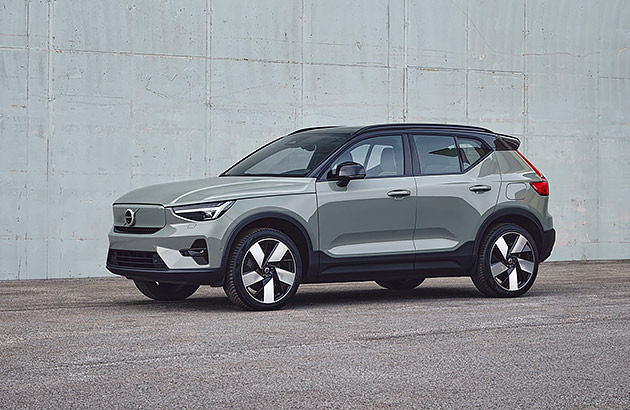
Volvo’s first EV, the XC40 Recharge, sees big changes for 2024.
The Chinese-built Swedish small SUV has switched from front-drive to rear-drive, while gaining faster charging capability and a bigger battery option.
In Single Motor models, a revised 175kW motor powered by an updated 69kWh battery drives the rear wheels, bumping up range by 10 per cent. There’s also a new 82kWh ‘Extended Range’ (ER) battery option, bringing with it a 185kW motor.
Need extra traction? The Twin Motor models adopt the 82kWh ER battery but ditch the old 150kW motors on each axle for a 183kW unit out back and fresh 117kW asynchronous motor up front.
A 50kW DC public outlet will charge either battery sizes from 10-80 per cent in about 70 minutes, or to 100 per cent in 11 hours with an optional 7kW Wallbox and 34hr using a household plug (ER is 13hr and 41hr respectively).
Solid and sensible, the XC40 Recharge is roomy, practical and comfortable.
| Motor: | Synchronous electric permanent-magnet |
|---|---|
| Transmission/drive: | Single-speed reduction gear/RWD or AWD |
| Battery: | 69kWh, 82kWh (ER), Lithium Ion |
| Power/torque: | 175kW/420Nm, 185kW/420Nm, 300kW/670Nm |
| 0-100km/h: | 7.3s, 7.3s, 4.8s |
| Consumption: | 16.8, 16.7, 17.7kWh/100km |
| Electric range: | 460km, 515km, 500km |
| Warranty: | 5yr/unlimited km |
| Battery warranty: | 8yr/160,000km |
| Safety rating: | 5 stars |
Volvo C40 Recharge Pure Electric from $78,990
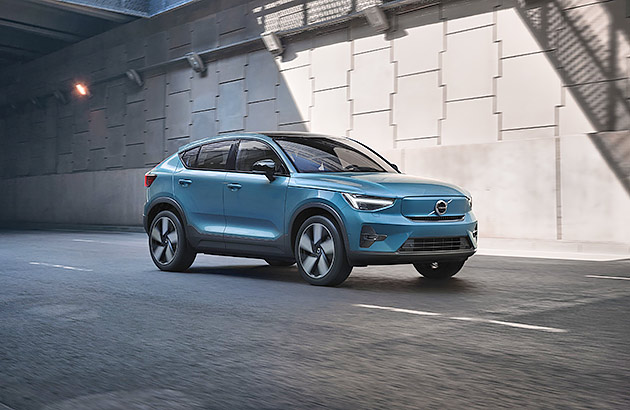
Essentially a coupe version of the boxy XC40 SUV, the stylish C40 is the first EV-only Volvo model.
In 2023, the Chinese-made Swede went from front-drive to rear-drive, while gaining improved efficiency, faster charging and an extended range (ER) battery option.
In Single Motor models, a revised 175kW motor powered by an updated 69kWh battery drives the rear wheels, for a 10 per cent range improvement. Plus, a new ER 82kWh battery option arrives, along with a 185kW motor.
The Twin Motor also goes ER, while replacing the previous 150kW motors per axle for 117kW asynchronous (front) and 183kW (rear) items.
A 50kW DC public outlet will charge either battery sizes from 10-80 per cent in approximately 70 minutes, or to 100 per cent in 11 hours with an optional 7kW Wallbox and 34 hours using a household plug (ER is 13hr and 41 hours respectively).
Though lower than the XC40, the C40 is still reasonably roomy, albeit with more compromised rear headroom. Its sleeker aerodynamics results in slightly better performance and range.
| Motor: | Synchronous electric permanent-magnet |
|---|---|
| Transmission/drive: | Single-speed reduction gear/RWD or AWD |
| Battery: | 69kWh, 82kWh (ER), Lithium Ion |
| Power/torque: | 175kW/420Nm, 185kW/420Nm, 300kW/670Nm |
| 0-100km/h: | 7.3s, 7.3s, 4.7s |
| Consumption: | 16.3, 16.3, 17.4kWh/100km |
| Electric range: | 476km, 533km, 507km |
| Warranty: | 5yr/unlimited km |
| Battery warranty: | 8yr/160,000km |
| Safety rating: | 5 stars |
Lexus UX 300e from $80,720
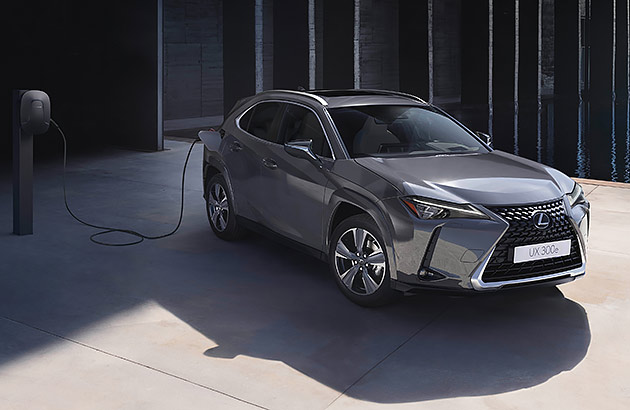
Aimed at the Mercedes EQA and Volvo XC40 Recharge, the UX 300e is the electrified version of Lexus’ small SUV/crossover that’s also available as a petrol and petrol-hybrid.
Replacing the previous 54.4kWh battery version, the updated 72.8kWh model sees range leap from 315km to 440km. But then so has the price.
That bigger battery extends charge times. Roughly speaking, to go from 10-80 per cent using a 50kW DC public charger, you’ll need around 80 minutes, about 12 hours to 100 per cent with an optional 7kW Wallbox and about 40 hours plugged in a normal household socket.
Another change for 2024 is an updated cabin with a larger touchscreen, while the body has been made stronger to improve steering, handling and ride qualities, according to Lexus. There’s also improved safety.
While not big on back-seat or boot space, the UX 300e is a sumptuous, enjoyable and high-quality compact luxury EV from Japan.
| Motor: | Synchronous electric permanent-magnet |
|---|---|
| Transmission/drive: | Single-speed reduction gear/FWD |
| Battery: | 72.8kWh Lithium Ion |
| Power/torque: | 150kW/300Nm |
| 0-100km/h: | 7.5s |
| Consumption: | 17.0 kWh/100km (estimated) |
| Electric range: | 440km |
| Warranty: | 5yr/unlimited km |
| Battery warranty: | 10yr/1,000,000km |
| Safety rating: | 5 stars |
BMW iX2 from $82,900
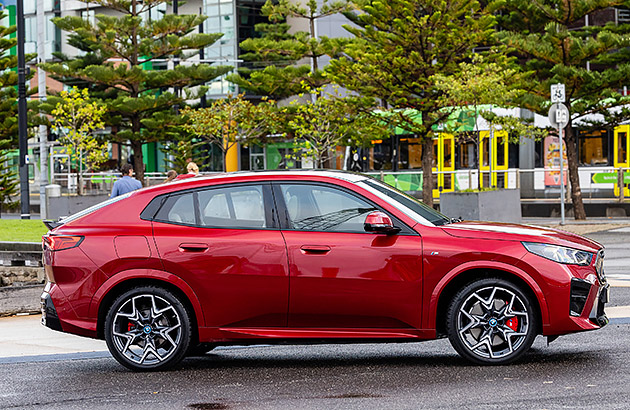
BMW’s propensity for coupe versions of its vast SUV range extends to its smallest, the X1, with the X2.
While the latest series released in 2024 is the second generation to wear that badge, it’s the first with an EV model, known as the iX2. Key rivals include the Tesla Model Y, Mercedes-Benz EQA and Volvo EC40 Coupe.
Like the identical-under-the-skin iX1, it is available in single-motor front-drive eDrive20 and rapid twin-motor all-wheel drive eDrive30, with both skewered towards sportier performance and handling, to keep in line with the sleeker styling.
Space to spread out up front, a stylish dash, intuitive touchscreens, generous equipment levels and a big boot are further plus points, though the divisive styling does limit rear-seat headroom for taller folks.
Using a 50kW DC charger, an 80 per cent top-up needs about 75 minutes, 11 hours with a 7kW Wallbox or under 36 hours with a regular socket.
| Motor: | Synchronous electric permanent-magnet |
|---|---|
| Transmission/drive: | Single-speed reduction gear/RWD, AWD |
| Battery: | 65kWh Lithium Ion |
| Power/torque: | 150kW/247Nm, 230kW/494Nm |
| 0-100km/h: | 8.6s, 5.6 |
| Consumption: |
16.3, 17.7kWh/100km |
| Electric range: | 439km, 417km |
| Warranty: | 5yr/unlimited km |
| Battery warranty: | 8yr/1,000,000km |
| Safety rating: | N/A |
Mercedes-Benz EQA from $84,900
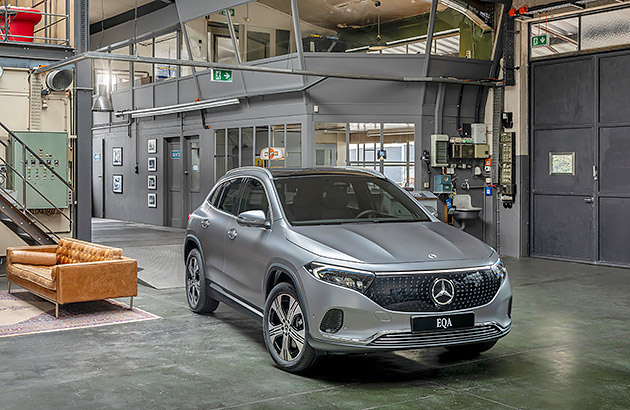
Aimed at the Tesla Model Y, the EQA is a successful high-riding premium hatchback crossover based on the popular GLA.
Facelifted in 2024, the new EQA250+ offers a single motor with modest performance, but is tuned for maximum efficiency. Meanwhile, the EQA350 4Matic employs two motors for all-wheel drive security and substantially stronger performance.
With larger batteries now fitted, a 50kW DC top up to 80 per cent needs around 70 minutes per model, or between 11 and 12 hours to 100 per cent with an optional 7kW Wallbox and between 34 and 36 hours plugged in at home.
The EQA lifts much of the GLA’s interior architecture, so it’s stylish and classy, and that’s no bad thing. Cabin space is reasonable too, but the 340-litre cargo capacity is disappointingly small.
Standard items include adaptive dampers and a dynamic steering mode, promoting best-possible ride and handling characteristics. Though now ageing, the EQA is still fun.
| Motor: | Synchronous electric permanent-magnet |
|---|---|
| Transmission/drive: | Single-speed reduction gear/FWD |
| Battery: | 73.9kWh Lithium Ion |
| Power/torque: | 140kW/385Nm and 215kW/520Nm |
| 0-100km/h: | 8.9s/6.0s |
| Consumption: | 16.4, 18.6 kWh/100km |
| Electric range: | 426km / 489km |
| Warranty: | 5yr/unlimited km |
| Battery warranty: | 8yr/160,000km |
| Safety rating: | 5 stars |
BMW iX1 from $78,900
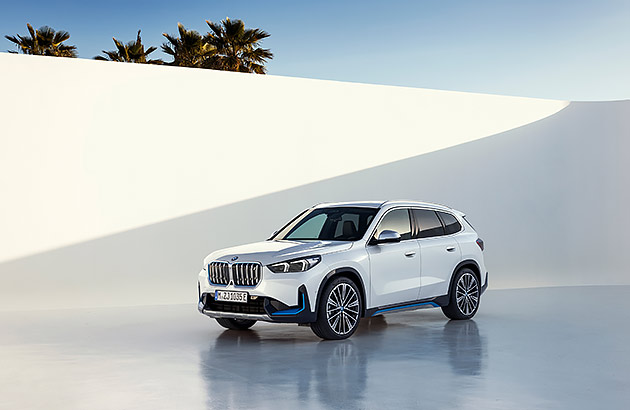
BMW’s handsome and well-proportioned third-generation X1 is a huge improvement over previous versions, making it a great basis for the fresh iX1 EV version.
Besides looking better, it’s also far-more stylish inside, with a large and airy interior brimming with tech, including a thoughtful touchscreen interface. There’s also a handy 490L of cargo capacity,
Two versions are available. The eDrive20 has a single motor driving the front wheels (FWD), while the xDrive30 adds another to the front axle for all-wheel drive (AWD).
Using a 50kW DC charger, an 80 per cent refill needs about 75 minutes, 11 hours with a 7kW garage Wallbox or around 34 hours plugged in at home.
To improve interior space efficiency without degrading dynamics, BMW says the German-built iX1 employs a flexible architecture that allows for larger battery packs to be placed lower down.
Result? The steering, ride and handling are on-brand, making this a compact EV SUV for drivers.
| Motor: | Synchronous electric permanent-magnet |
|---|---|
| Transmission/drive: | Single-speed reduction gear/AWD |
| Battery: | 65kWh Lithium Ion |
| Power/torque: | 230kW/494Nm |
| 0-100km/h: | 5.6s |
| Consumption: | 18.4kWh/100km |
| Electric range: | 438km |
| Warranty: | 5yr/unlimited km |
| Battery warranty: | 8yr/160,000km |
| Safety rating: | N/A |
MID-SIZE SUVs
Leapmotor C10 from $45,888
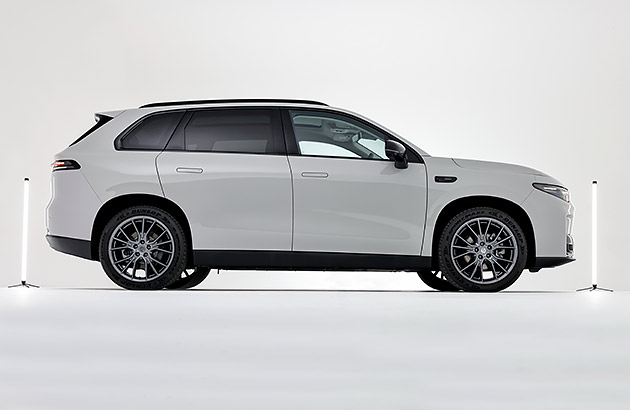
Chinese start-up upstart Leapmotor’s first vehicle in Australia is the C10.
Undercutting every other equivalently-sized EV by up to tens of thousands of dollars, this five-seater SUV is roomier than a Toyota RAV4, features a contemporary touchscreen-centric interior and brims with standard features – including a glass roof.
Performance is adequate, the C10’s steering is light and the full suite of driver-assist safety tech can be overly-zealous to alert and even intervene, so Australian-road tuning work needs to be done here.
The electric motor is mounted out back, driving the rear wheels, while the architecture features a normal 400-volt charging capability, to help keep prices down.
To that end, plugged in at home, it needs 34 hours to fully charge the battery; using an optional 7kW Wallbox slashes that to 12hrs, while a 50kW DC outlet gets the job done from 10 to 80 per cent full in 65 minutes.
Nothing ground-breaking here, then, except for the sensationally low price.
| Motor: | Synchronous electric permanent-magnet |
|---|---|
| Transmission/drive: | Single-speed reduction gear/RWD |
| Battery: | 69.9kWh Lithium Iron Phosphate |
| Power/torque: | 160kW/320Nm |
| 0-100km/h: | 7.5s |
| Consumption: | 19.8kWh/100km |
| Electric range: | 420km |
| Warranty: | 7yr/160,000km |
| Battery warranty: | 8yr/160,000km |
| Safety rating: | N/A |
Tesla Model Y from $55,900
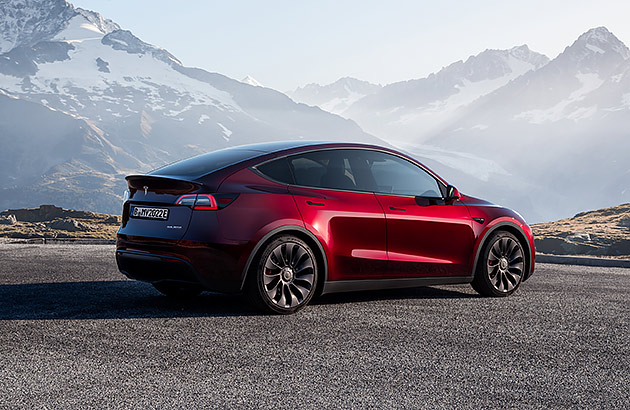
Based on the Model 3 sedan, the newer Model Y is longer, taller and wider, with extra ground clearance and more-family-friendly packaging, complete with a tailgate. Yep, it’s the SUV version.
The Rear-Wheel Drive (RWD) with a single motor and 60kWh battery is the base grade, followed by the Long Range and Performance flagship. Both add dual motors for all-wheel drive (AWD) and an 80kWh battery.
For the AWD Ys, Tesla’s powerful Supercharger Network can provide hundreds of kilometres of range in around 30 minutes, a 50kW DC public charger needs 75mins to go from 10-80 per cent full, or otherwise for a 100 per cent charge you’ll require about 12 hours with an optional 7kW Wallbox, or nearly 40 hours plugged in at home/work. The RWD needs about one-quarter less time to replenish.
The Model Y adopts the minimalist single-tablet dash look inside, but with greater space for five adults and deeper windows for an airier feel than the 3. That’s why it's already a bestseller.
| Motor: | Synchronous electric permanent-magnet |
|---|---|
| Transmission/drive: | Single-speed reduction gear/RWD or AWD |
| Battery: | 60kWh Lithium Iron Phosphate (LFP) – RWD 80kWh Nickel-manganese-cobalt (NMC) – AWD |
| Power/torque: | 194kW/340Nm, 378kW/493Nm, 413kW/660Nm |
| 0-100km/h: | 6.9s, 5.0s, 3.7s |
| Consumption: | 15.7, 16.9, 17.1kWh/100km |
| Electric range: | 455km, 533km, 514km |
| Warranty: | 4yr/80,000km |
| Battery warranty: | 8yr/160,000km |
| Safety rating: | 5 stars |
Kia EV5 from $57,770 Drive-away*
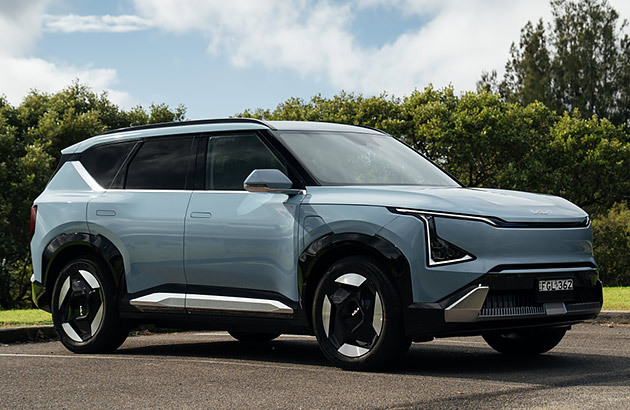
The first Kia from China, the EV5 is sharp in styling and pricing.
Modern and attractive, the spacious and airy five-seat cabin is dominated by intuitive twin screens, stacks of storage and a bench-like front seat area, though only two people can travel on them.
The base Air uses a smaller (BYD-sourced) battery than the 88.1kWh item in the others.
Riding on a 400-volt EV architecture co-developed with a Chinese partner (instead of the 800V platform found in Kia’s EV6 and up), a front-mounted motor drives the front wheels, while a second, rear-sited motor adds all-wheel drive.
Tuned in Australia, the driving experience is easy if unexciting, with ample performance, light steering and a firm but comfy ride.
Maximum charging times is roughly 32 hours plugged in at home and 11hrs with an optional 7kW Wallbox, or about 60 minutes using a 50kW DC charger to 80 per cent full. Add 30 percent extra time for the bigger battery.
| Motor: | Synchronous electric permanent-magnet |
|---|---|
| Transmission/drive: | Single-speed reduction gear/FWD, AWD |
| Battery: | 64.2kWh, 88.1 Lithium Iron Phosphate |
| Power/torque: | 160kW/310Nm, 230kW/480Nm |
| 0-100km/h: | 8.5s, 8.9s, 6.1s, 6.5s |
| Consumption: | 18.2kWh, 18.0kWh, 20.1kWh, 21.0kWh/100km |
| Electric range: | 400km, 555km, 500km, 470km |
| Warranty: | 7yr/unlimited km |
| Battery warranty: | 8yr/150,000km |
| Safety rating: | 5 stars |
Ford Mustang Mach-E from $64,990
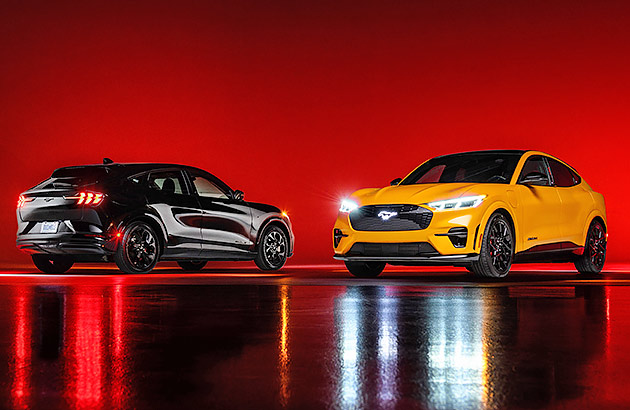
Sharing nothing but evocative styling cues with the Mustang sports car, the Mach-E is a five-door SUV, using an electrified version of the related Escape’s architecture.
Made in Mexico, outputs are: 198kW/430Nm for the base Select rear-drive with a 71kWh battery and 470km range, 216kW/430Nm for Premium rear-drive with a 91kWh battery and 600km range, and 358kW/860Nm and 490km range for the high-performance GT twin-motor all-wheel drive with the same-size battery.
Note the Mach-E has absolutely no off-road capabilities.
Being an SUV means family-friendly packaging, with space for five. The Mach-E is also a step forward for Ford interior design, with a very modern look and feel.
Using a 7kW Wallbox takes 12 hours to recharge the 71kWh battery (91kWh: 15hr), 70 minutes using a 50kW DC outlet (91kWh: 90min), while nearly 40 hours is required with a home plug (91kWh: 50hr).
The Mach-E's retro styling, its stirring performance and great handling round out a unique and emotional EV proposition.
| Motor: | Synchronous electric permanent-magnet |
|---|---|
| Transmission/drive: | Single-speed reduction gear/RWD or AWD |
| Battery: | 71kWh or 91kWh Lithium Iron Phosphate |
| Power/torque: | 198,216,358kW and 430,430,890Nm |
| 0-100km/h: | 3.8-6.1s |
| Consumption: | 16.5-19.5kWh/100km |
| Electric range: | 470-600km (WLTP) |
| Warranty: | 5yr/unlimited km |
| Battery warranty: | 8yr/160,000km |
| Safety rating: | 5 stars |
Toyota bZ4X from $66,000
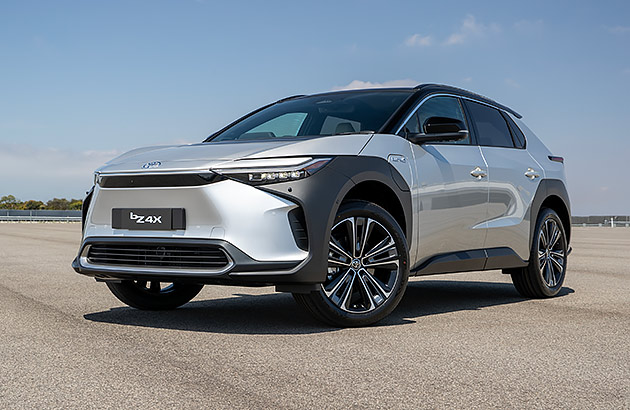
The bZ4X (for ‘Beyond Zero emissions ‘4’ X-over) is Toyota’s first battery EV. After years of delays, Australia finally saw it (and the identical Subaru Solterra) in early 2024 but sales have been slow.
Related to the Lexus RZ, the RAV4-esque five-seater midsized SUV features a flat floor to maximise space, creating a comfy, airy and inviting cabin that’s big on high-tech features.
A 150kW motor drives the front wheels, while an 80kW motor on each axle powers the 160kW all-wheel-drive version. The company reckons these outputs are conservative to promote long life and reliability. For now, all grades use a 71.4kWh battery. Typical Toyota.
A 50kW DC fast charger gives an 80 per cent charge in 65 minutes. An optional 7kW Wallbox needs about 12 hours to go 100 per cent, or about 33 hours if plugged in at home.
Strikingly futuristic and surprisingly fun to drive, the bZ4X is the first of many coming Toyota EVs.
| Motor: | Synchronous electric permanent-magnet |
|---|---|
| Transmission/drive: | Single-speed reduction gear/FWD or AWD |
| Battery: | 71.4kWh Lithium Ion |
| Power/torque: | 150kW/265Nm (AWD: 160kW/336Nm) |
| 0-100km/h: | 7.5 (AWD: 6.9s) |
| Consumption: | 14.4kWh/100km (AWD: 16.2) |
| Electric range: | 516km (AWD: 461km) |
| Warranty: | 5yr/unlimited km |
| Battery warranty: | 10yr/240,000km |
| Safety rating: | 5 stars |
Hyundai Ioniq 5 from $69,800
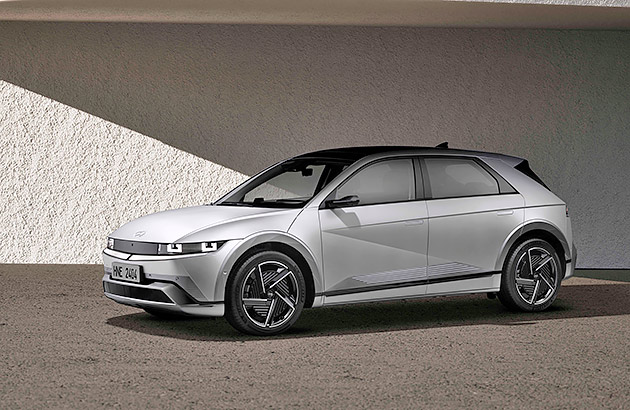
Strikingly designed, surprisingly spacious, highly modern inside and very advanced, the Ioniq 5 makes for a great family crossover, with a massive luggage area and even a boot up front.
Updated during 2024, the Series II comes in single motor/rear-drive Standard Range (SR) or Extended Range (ER) configurations, as well as dual-motor all-wheel-drive ER.
The Ioniq 5’s 800V architecture allows for an 80 per cent charge in under 55 minutes using a 50kW DC outlet for the SR. Otherwise, it’s about 10 hours to full via an optional 7kW Wallbox or 31hrs plugged in at home. Add about 25 per cent more time for the ER battery models.
Along with strong, smooth performance and controlled handling, the ability to power electric appliances and even return electricity to the grid are further virtues.
Finally, regarded as a separate model, the $110K-plus 478kW/740Nm Ioniq 5 N AWD hits 100km/h in 3.4s and 260km/h, while averaging 22.4kWh/100km and 450km between recharges.
| Motor: | Synchronous electric permanent-magnet |
|---|---|
| Transmission/drive: | Single-speed reduction gear/RWD or AWD |
| Battery: | 63kWh/84kWh RWD/AWD Lithium Ion |
| Power/torque: | 125kW/350Nm RWD, 165kW/350Nm AWD |
| 0-100km/h: | 8.5s, 7.5s, 5.3s |
| Consumption: | 15.6, 17.2, 18.2kWh/100km |
| Electric range: | 440km, 495-570km |
| Warranty: | 5yr/unlimited km |
| Battery warranty: | 8yr/160,000km |
| Safety rating: | 5 stars |
Skoda Enyaq from $69,990
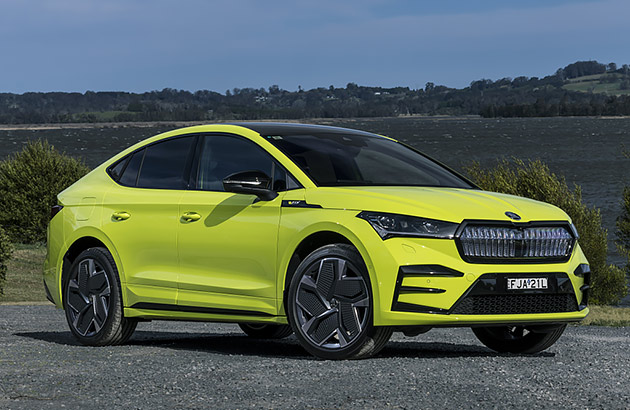
Taking years to reach Australia, the Skoda Enyaq is a Czech-built midsized SUV-coupe from the VW Group, and is related to the Audi Q4 e-tron.
Neat if a little dated inside, the interior seats five in ample space and relative comfort, the boot is big and equipment levels are generous.
However, that swoopy roofline does limit headroom for taller rear-seat passengers. And having no shade cover for the glass roof makes no sense under the hot Australian sun.
With a sporty focus, there’s a single-motor rear-drive version or one with a dual-motor for all-wheel drive. Performance is strong and overall it is an easy drive, but a firm ride might discourage family buyers.
Plugged in at home, you’ll need about 40 hours or 13hrs using an optional 7kW Wallbox to 100 per cent, or around 70 minutes from 10 to 80 per cent if you find a 50kW DC charger.
Athletic and offbeat, the Enyaq is a competent EV SUV.
| Motor: | Synchronous electric permanent-magnet (rear), asynchronous (front) |
|---|---|
| Transmission/drive: | Single-speed reduction gear/RWD, AWD |
| Battery: | 82kWh Lithium Ion |
| Power/torque: | 82kWh Lithium Ion |
| 0-100km/h: | 210kW/545Nm, 250kW/545Nm |
| Consumption: | 15.5kWh, 16.3kWh/100km |
| Electric range: | 561km, 530km |
| Warranty: | 7yr/unlimited km |
| Battery warranty: | 8yr/150,000km |
| Safety rating: | 5 stars |
Subaru Solterra from $69,990
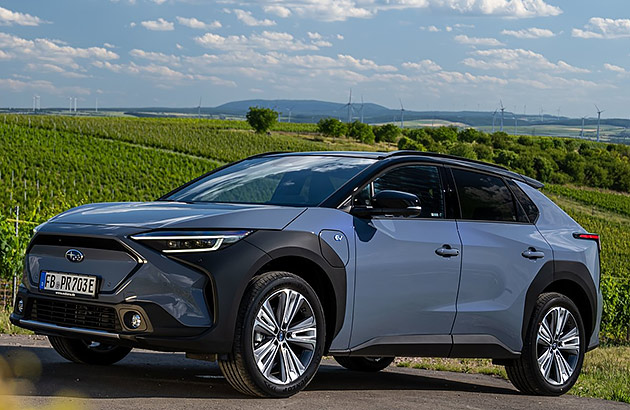
More than merely a badge-engineered version of the Toyota bZ4X, the Subaru Solterra is Subaru’s first EV for Australia.
Aimed at the Kia EV6 and Hyundai Ioniq 5, it is a midsized SUV with five seats and plenty of multimedia and driver-assist safety tech to help justify its lofty pricing. The boot is also family-sized, underlining the EV’s sensible packaging.
Australian-bound models feature an 80kW motor on each axle for all-wheel drive, resulting in a 160kW power maximum, while a 71.4kWh battery offers a range of 460km.
One big difference between the Toyota and Subaru EVs is the latter’s emphasis on lifestyle adventure and (limited) off-road capability, with extra body cladding and noticeably greater ground clearance – 210mm vs 177mm.
A 50kW outlet needs about 65 minutes to go from 10 to 80 per cent full, while an optional 7kW Wallbox requires approximately 12 hours compared to about 33 hours using the normal mains to reach maximum charge.
| Motor: | Synchronous electric permanent-magnet |
|---|---|
| Transmission/drive: | Single-speed reduction gear/AWD |
| Battery: | 71.4kWh Lithium Ion |
| Power/torque: | 160kW/336Nm |
| 0-100km/h: | 6.9s |
| Consumption: | 16.0kWh/100km |
| Electric range: | 460km |
| Warranty: | 5yr/unlimited km |
| Battery warranty: | 8yr/160,000km |
| Safety rating: | 5 stars |
Polestar 4 from $81,500
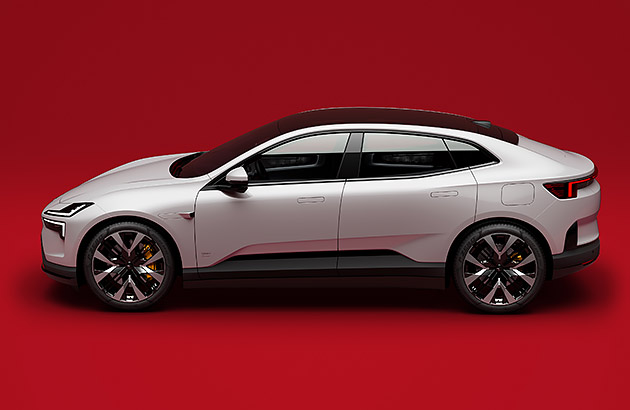
Polestar’s 4 stands apart from other premium midsized SUVs like the Tesla Model Y with a low-slung design that has no back window. Controversial.
Reverse cameras take its place instead, and actually almost every adjustment (including seats, mirrors and steering column) within the airy, minimalist and vast interior is via a touchscreen that requires patience to master.
Swedish designed and Chinese built, the 4 brings two Long Range (LR) grades initially – a Single Motor (SM) rear-drive and Dual Motor (DM) all-wheel drive, with the latter boasting dramatic acceleration. A base Standard Range SM model is also coming.
Charging the big 100kWh battery to 80 per cent using a 50kW DC outlet needs around 85 minutes, 15 hours to 100 per cent with a home socket or nearly 50hrs via an optional 7kW Wallbox.
Offering real presence, Polestar’s 4 is quick, easy and comfy to drive, and an offbeat EV alternative.
| Motor: | Synchronous electric permanent-magnet |
|---|---|
| Transmission/drive: | Single-speed reduction gear/FWD |
| Battery: | 73kWh (SR), 98kWh (LR) Lithium Ion |
| Power/torque: | 157kW/345Nm (SM SR) + 83kW/166Nm (DM SR), 171kW (SM LR) |
| 0-100km/h: | 6.4s/8.7s/8.9s (DM SR/SM SR/SM LR) |
| Consumption: | 16.7 kWh/100km (SM SR) |
| Electric range: | 525km (SR), 700km (LR) |
| Warranty: | 5yr/80,000km |
| Battery warranty: | 8yr/160,000km |
| Safety rating: | N/A |
Audi Q4 e-tron from $88,300
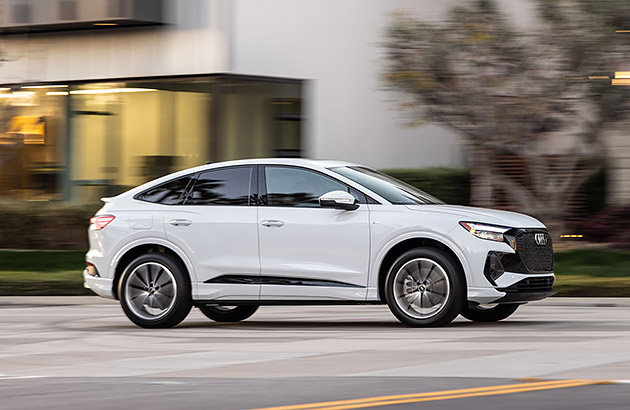
Audi has offered high-end EVs in Australia since 2020, but the Q4 e-tron plays at the heart of the market, against the bestselling Tesla Model Y.
Slightly smaller than the popular Q5, the good-looking German EV offers buyers two body shapes – a family-orientated SUV wagon and sleeker Sportback SUV coupe. Both are spacious five seaters, with tech-heavy high-quality interior presentations, with plenty of safety on offer and large cargo areas.
The 45 has a rear-mounted electric motor driving the rear wheels, while the 55 quattro adds a 75kW motor up front for all-wheel drive. Both come with a sizeable 82kWh battery.
Charging to 80 per cent using a 50kW DC outlet needs around 70 minutes, or 40 hours to 100 per cent with a home socket and over 12 hours via an optional 7kW Wallbox.
Audi has tuned both Q4 e-trons to deliver speed and agility, while also providing a supple ride. It’s bound to prove popular.
| Motor: | Synchronous, Synchronous + Asynchronous |
|---|---|
| Transmission/drive: | Single-speed reduction gear/RWD, AWD |
| Battery: | 82kWh Lithium Ion |
| Power/torque: | 210kW/545Nm, 250kW/679Nm |
| 0-100km/h: | 6.9s, 5.4s |
| Consumption: | 16.7kWh/100km, 19.4kWh/100km |
| Electric range: | 490km, 450km |
| Warranty: | 5yr/80,000km |
| Battery warranty: | 8yr/160,000km |
| Safety rating: | 5 stars |
Mercedes-Benz EQB from $89,100
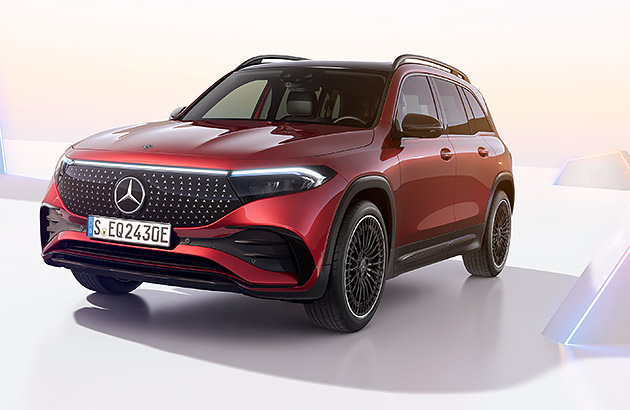
Mercedes-Benz’s big-selling GLB seven-seater midsized SUV goes electric with the EQB.
Mercedes-Benz’s EQB midsized SUV went under the scalpel during 2024, with minor grille and tail-light updates, and more equipment than before.
The interior, which is essentially the same found in the petrol-powered GLB, has been spruced up with better-quality materials too. Cargo capacity is a family-friendly 495L.
The EQB is now down to a single, five-seater EQB250+ grade, driving the front wheels via a front-mounted electric motor. This means the old EQB250 (no plus) seven-seater, and more-powerful EQB350 4Matic models are gone.
Charging the larger battery to 80 per cent using a 50kW DC station will need around 70 minutes, or under 12 hours to 100 per cent with an optional 7kW Wallbox. Going with a household plug blows that out to over 36hrs.
Despite looking tall and narrow, the EQB is an enjoyable drive. While not strident like rival EVs at this price, it’s smooth, with response steering and a pleasant ride. But the price is steep.
| Motor: | Synchronous electric permanent-magnet |
|---|---|
| Transmission/drive: | Single-speed reduction gear/AWD |
| Battery: | 73.9kWh Lithium Ion |
| Power/torque: | 140kW/385Nm |
| 0-100km/h: | 8.9s |
| Consumption: | 17.5kWh/100km |
| Electric range: | 463km |
| Warranty: | 5yr/unlimited km |
| Battery warranty: | 8yr/160,000km |
| Safety rating: | 5 stars |
BMW iX3 from $89,100
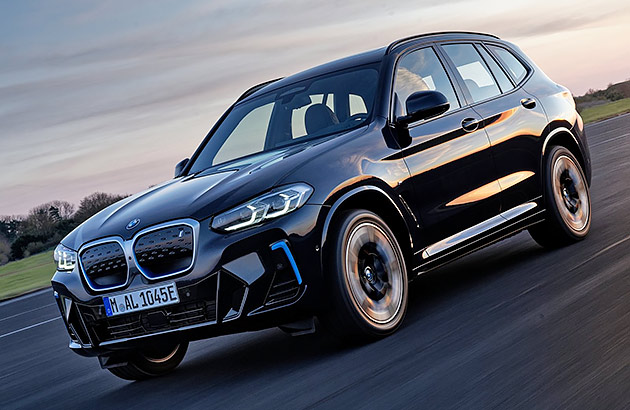
An electrified version of the popular but ageing X3 medium-sized SUV, the iX3 is now getting old. An all-new and much-more technically-advanced version is waiting in the wings.
Still, with a 210kW/400Nm electric motor to drive the rear wheels only, it brings both spirited performance and sufficient efficiency. Otherwise, the EV is as-per the existing X3, boasting a spacious and practical interior with ample room for five occupants, as well as high quality materials.
With a 50kW DC charger, an 80 per cent top-up needs about 75 minutes – or otherwise the optional 7kW Wallbox needs 12 hours to a full charge, while a home plug-in session could last 38hrs.
BMW’s acclaimed OS 7.0 multimedia system is fitted, capable of over-the-air updates. Among a host of standard features, adaptive dampers that prioritise softness are part of the package.
| Motor: | Synchronous electric permanent-magnet |
|---|---|
| Transmission/drive: | Single-speed reduction gear/RWD |
| Battery: | 80kWh Lithium Ion |
| Power/torque: | 210kW/400Nm |
| 0-100km/h: | 6.8s |
| Consumption: | 19.5kWh/100km |
| Electric range: | 460km |
| Warranty: | 3yr/unlimited km |
| Battery warranty: | 8yr/160,000km |
| Safety rating: | 5 stars |
Genesis GV60 from $103,384
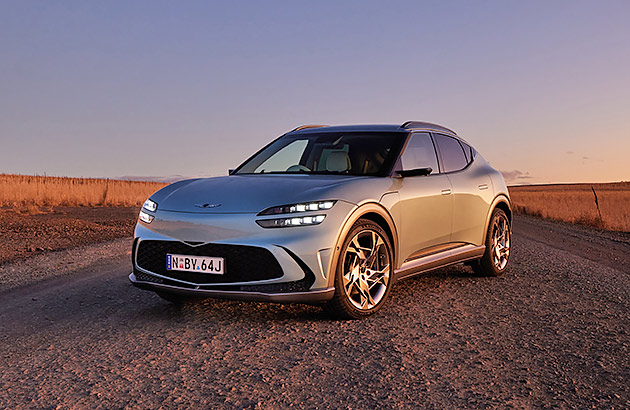
Related to the Hyundai Ioniq 5 and Kia EV6, the stylish and striking Genesis GV60 midsized luxury SUV is chasing BMW iX1 and Tesla Model Y buyers.
Two powertrain choices exist ¬– a 234kW dual-motor all-wheel and 320kW AWD Sports version, the latter offering a 360kW overboost function for extra thrust. Both feature a 77.4kWh battery, with a WLTP range of 470km and 466km respectively.
A 50kW DC charger needs only 65 minutes to go from 10-80 per cent, an optional 7kW Wallbox at home reaches 100 per cent in 12 hours, while a regular household outlet needs nearly 40 hours. ‘Vehicle to Load’ (V2L) capability allows the Genesis to act like a big-appliance generator.
Other standout tech features include video side mirrors, facial recognition entry and fingerprint reader gear-shift release.
Factor in value pricing, lots of equipment and plenty of safety tech, and it’s clear Genesis is serious about leading the luxury EV SUV pack.
| Motor: | Synchronous electric permanent-magnet |
|---|---|
| Transmission/drive: | Single-speed reduction gear/AWD |
| Battery: | 77.4kWh Lithium Ion |
| Power/torque: | 234kW/605Nm, 360kW/700Nm |
| 0-100km/h: | 5.2/4.0 s |
| Consumption: | 18.8/19.1kWh/100km |
| Electric range: | 470/466km |
| Warranty: | 5yr/unlimited km |
| Battery warranty: | 8yr/160,000km |
| Safety rating: | 5 stars |
Lexus RZ from $121,059
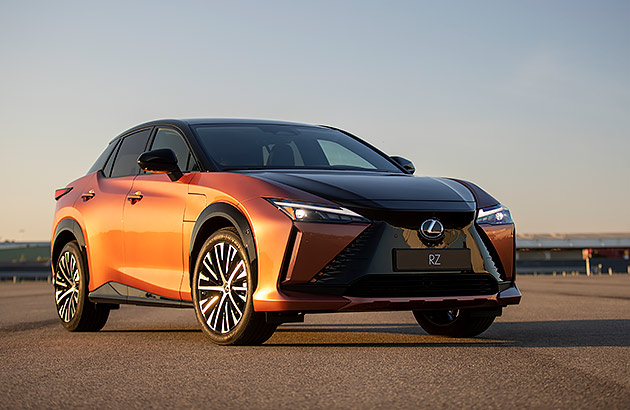
Lexus’ second all-electric vehicle, the RZ, is a medium-sized luxury SUV that’s closely related to the Toyota bZ4X.
One model is here for now – the RZ 450e – in Sport and Sport Luxury grades.
Built on an electrified variation of the Toyota New Global Architecture, there’s an electric motor on each axle for all-wheel drive, with maximum power of 230kW, and a 71.4kWh lithium-ion battery stored in between.
With a very-Lexus look inside and out, there’s nothing unfamiliar about the RZ – except for its available steering yoke – a steer-by-wire technology that cuts steering turns by two-thirds. Even the tightest U-turn requires barely over half a circle.
Find a 50kW DC charger, and the RZ can be charged from 10-80 per cent in under 70 minutes, or to 100 per cent in 12 hours using an optional 7kW Wallbox. A household plug needs about 33 hours or so.
Rivals include the BMW iX and Mercedes EQC.
| Motor: | Synchronous electric permanent-magnet |
|---|---|
| Transmission/drive: | Single-speed reduction gear/AWD |
| Battery: | 77.4kWh Lithium Ion |
| Power/torque: | 230kW/435Nm |
| 0-100km/h: | 5.6s |
| Consumption: | 18.3.0kWh/100km |
| Electric range: | 470km |
| Warranty: | 5yr/unlimited km |
| Battery warranty: | 8yr/160,000km |
| Safety rating: | N/A |
Porsche Macan from $128,400
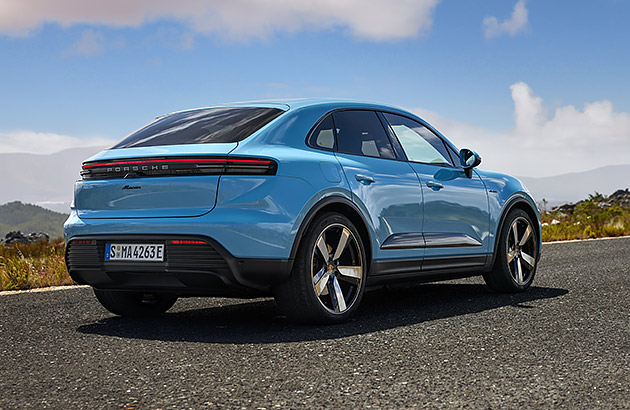
With conventional petrol powertrains, the original Porsche Macan proved to be one of the most successful vehicles of recent history.
Bravely, the Germans have gone EV only for the similar-looking second-gen version, sharing its all-new architecture with the coming, related Audi Q6 e-tron.
As is the norm nowadays, there’s a rear-mounted motor for rear-drive in the base Macan Electric and an additional unit up front for the dual motor Macan 4, 4S and 4 Turbo. The latter can rocket up to 260km/h.
A dazzling multi-screen layout dominates the solid, high-quality interior, featuring superb seating and excellent ergonomics, though rear-seat space is a bit tight.
Charging the huge 100kWh battery to 80 per cent from a 50kW DC outlet requires about 90 minutes, or nearly 50 hours to 100 per cent using a home socket and 15 hours-plus via an optional 7kW Wallbox.
Familiar yet now completely different now, the Macan EV is one of the world’s grand touring greats.
| Motor: | Synchronous electric permanent-magnet |
|---|---|
| Transmission/drive: | Single-speed reduction gear/RWD, AWD |
| Battery: | 100kWh Lithium – Nickel Manganese Cobalt |
| Power/torque: | 265kW/563Nm, 300kW/650Nm, 380kW/820Nm, 470kW/1130Nm |
| 0-100km/h: | 5.7s, 5.2s, 4.1s, 3.3s |
| Consumption: | 17.0, 17.9, 17.7, 18.8 kWh/100km |
| Electric range: | 641km, 613km, 606km, 591km |
| Warranty: | 3yr/unlimited km |
| Battery warranty: | 8yr/160,000km |
| Safety rating: | N/A |
Genesis Electrified GV70 from $125,858
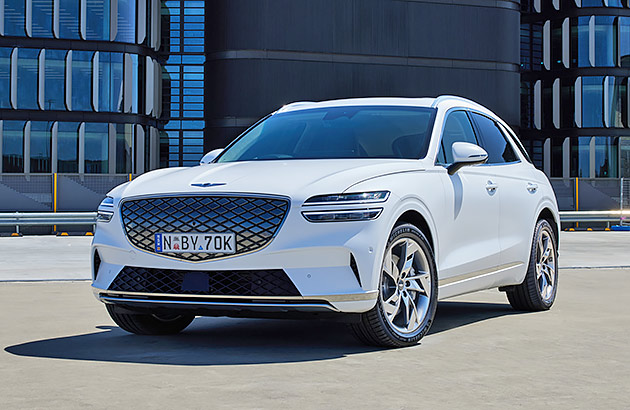
Also known as the eGV70, the Electrified GV70 is Hyundai luxury brand Genesis’ take on the Mercedes-Benz EQC and BMW iX.
Like its German rivals, this is an electrified version of an internal combustion engined vehicle.
A single powertrain choice is offered for now, with a 160kW motor at each end, though a brief overboost feature pushes the combined maximum output up to 360kW.
An 800-volt charging capability means a 350kW rapid charger will top the battery up from 10 to 80 per cent in under 20 minutes. Using a 50kW DC charger, the GV70 needs about 70 minutes for a 10 to 80 per cent top-up, or about 12 hours to 100 per cent with an optional 7kW Wallbox. Plugging in at home will take nearly 40 hours.
Plus, a V2L function allows for electrical appliances to be powered outside the vehicle.
Finally, some mild off-road capability is possible.
| Motor: | Synchronous electric permanent-magnet |
|---|---|
| Transmission/drive: | Single-speed reduction gear/AWD |
| Battery: | 77.4kWh Lithium Ion |
| Power/torque: | 320kW/700Nm (360kW on overboost) |
| 0-100km/h: | 4.2s |
| Consumption: | 19.2kWh/100km |
| Electric range: | 455km |
| Warranty: | 5yr/unlimited km |
| Battery warranty: | 8yr/160,000km |
| Safety rating: | 5 stars |
Mercedes-Benz EQE SUV from about $144,930 drive away*
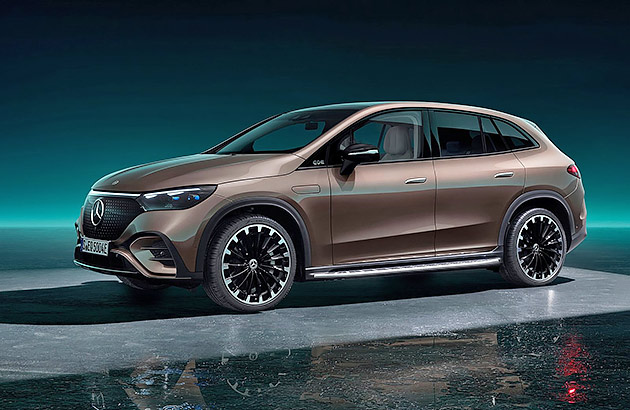
Much is riding on the EQE SUV – a model that Mercedes-Benz expects will be its bestselling EV globally.
A high-riding five-seater SUV wagon, the EQE SUV sits on the same advanced EVA architecture as the sedan, and slots above the discontinued EQC but under the EQS SUV.
Two drivetrain configurations are offered – a rear-mounted single motor rear-drive, with a second motor added on the front axle for all-wheel drive (AWD).
The EQE SUV’s dash is striking and high-tech, with few actual buttons and an advanced ‘Hey, Mercedes’ voice command system. Options include a vast ‘Hyperscreen’ dash with a trio of segmented displays, air suspension with adaptive dampers and four-wheel steering, to aid agility.
As with the sedan, a 50kW DC charger needs about 80 minutes to refill the large battery to 80 per cent. With the included 7kW Wallbox that’s around 15 hours, or under 48 hours using a regular socket.
The rapid AMG EQE53 4Matic costs north of $200,000.
| Motor: | Synchronous electric permanent-magnet |
|---|---|
| Transmission/drive: | Single-speed reduction gear/RWD or AWD |
| Battery: | 100kWh Lithium Ion |
| Power/torque: | 180kW/550Nm, 215kW/765Nm, 460kW/950Nm |
| 0-100km/h: | 7.6s, 6.6s, 3.7s |
| Consumption: | 17.7, 18.3, 22.6kWh/100km |
| Electric range: | 590km, 547km, 488km |
| Warranty: | 5yr/unlimited km |
| Battery warranty: | 8yr/160,000km |
| Safety rating: | 5 stars |
LARGE SUVs
Kia EV6 from $72,590
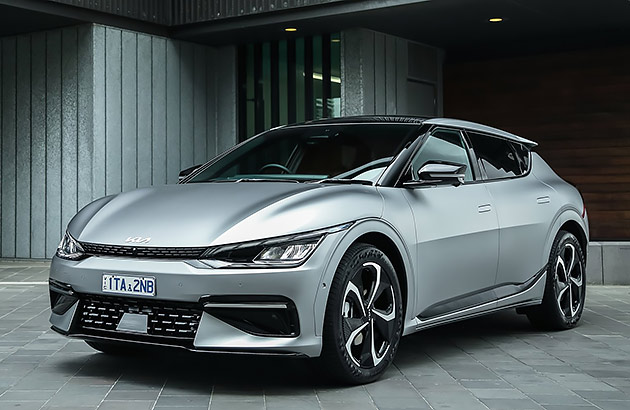
Kia’s swoopy EV6 employs the same 800-volt e-GMP electric architecture as the Hyundai Ioniq 5.
Along with its own body and interior, it also benefits from a unique Australian handling and ride tune.
Using an updated 77.4kWh battery, the EV6 Long Range comes in either a rear-mounted 168kW electric motor rear-drive model, or 74kW-front/165kW-rear 239kW dual-motor all-wheel drive guise.
There’s also a GT, Kia’s fastest, most powerful and most expensive car ever in Australia, with 430kW and 3.5 seconds from 0-100km/h.
Recharging from 10 to 80 per cent using a 50kW DC public fast charger needs 65 minutes. Otherwise, 100 per cent full using an optional 7kW Wallbox at home/work takes 12 hours respectively, to avoid a 38-hour wait plugged into a regular wall socket.
The EV6’s cabin looks premium, and is dominated by huge touchscreen designs incorporating multimedia and instrumentation.
Factor in ample space, generous equipment levels and leading safety, and Kia’s EV6 is a real game-changer.
| Motor: | Synchronous electric permanent-magnet |
|---|---|
| Transmission/drive: | Single-speed reduction gear/RWD or AWD |
| Battery: | 77.4kWh Lithium Ion |
| Power/torque: | 168kW/350Nm, 239kW/605Nm, 430kW/740Nm |
| 0-100km/h: | 7.3s/5.2s/3.5s |
| Consumption: | 16.5, 17.2, 20.6 kWh/100km |
| Electric range: | 528km, 400km, 370km |
| Warranty: | 7yr/unlimited km |
| Battery warranty: | 8yr/160,000km |
| Safety rating: | 5 stars |
Kia EV9 from $97,000
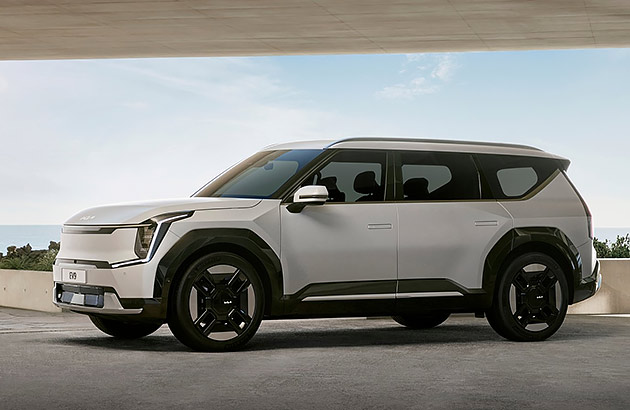
Big, brash and imposing, the Kia EV9 is Australia’s first three-row SUV EV, targeting premium petrol and hybrid alternatives with expansive space inside due to a huge wheelbase. Six or seven-seater choices are available.
There are two battery versions, starting with a 76.1kWh Standard Range (SR) with rear-wheel drive (RWD), using a 160kW/350Nm electric motor.
The Long Range (LR) RWD adopts a 99.8kWh battery, while the EV9 all-wheel drive (AWD) adds another motor up front.
Featuring Hyundai/Kia/Genesis’ lauded E-GMP 800-volt architecture for faster charging, a 50kW DC outlet will fill the LR battery to 80 per cent in under 90 minutes, or over 15 hours and 50hrs to 100 per cent with an optional 7kW Wallbox and home power-point respectively. Or about one-third less time with the SR.
Note that towing capacity is 2500kg (AWD only) and safety is said to be world-class.
Comfortable, smooth, fast and majestic in conduct, the brave and ambitious EV9 stands tall.
| Motor: | Synchronous electric permanent-magnet |
|---|---|
| Transmission/drive: | Single-speed reduction gear/RWD or AWD |
| Battery: | 76.1 or 99.8kWh Lithium Ion |
| Power/torque: | 160kW/350Nm and 283kW/600Nm |
| 0-100km/h: | 8.2s, 5.3-6.0s |
| Consumption: | 20.0, 22.8kWh/100km |
| Electric range: | 443km, 505-512km |
| Warranty: | 7yr/unlimited km |
| Battery warranty: | 8yr/160,000km |
| Safety rating: | 5 stars |
Cadillac Lyriq $117,000
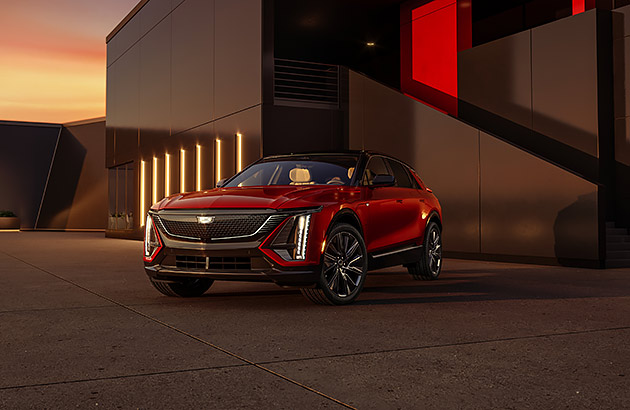
Cadillac is finally in Australia, after a false start with now-defunct Holden nearly two decades ago.
Keenly priced against the BMW iX, Mercedes EQE and Volvo EX90, the Lyriq is a sharply-designed five-seater midsized SUV from North America.
It brims with advanced luxury, including a massive 33-inch touchscreen display, a glass roof with sunshade and 19-speaker audio.
To achieve a comfortable and isolated ride experience, the Lyriq features hydraulic dampers and active noise cancellation.
With an electric motor on each axle for all-wheel drive, the Cadillac provides formidable acceleration and speed, as well as impressive dynamic control, while the large battery pack forms part of the architecture for extra strength and space efficiency.
Plugged in at home, the 108kWh battery needs over 52 hours to fully recharge or 16hrs with an optional 7kW Wallbox, while a 50kW DC outlet gets the job done to 80 per in under 90 minutes.
The Lyriq is offered in two variants: Luxury (chrome) or Sport (blacked-out trim).
| Motor: | Synchronous electric permanent-magnet |
|---|---|
| Transmission/drive: | Single-speed reduction gear/AWD |
| Battery: | 106.8kWh Lithium Ion |
| Power/torque: | 388kW/610Nm |
| 0-100km/h: | 5.3s |
| Consumption: | 22.5kWh |
| Electric range: | 530km |
| Warranty: | 5yr/unlimited km |
| Battery warranty: | 8yr/160,000km |
| Safety rating: | 5 stars |
Polestar 3 from $118,420
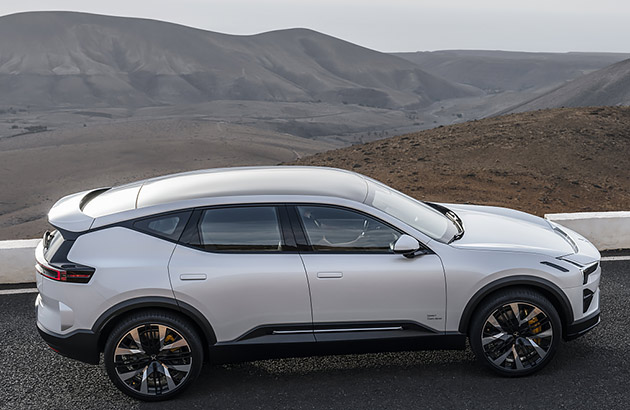
Twinned with the boxy Volvo EX90, the sleek, unconventionally-styled Polestar 3 is a larger EV SUV than the 4, and is chasing the likes of the BMW iX.
A long and wide five-seater, the on-brand minimalist interior features pampering seats, a massive if fiddly touchscreen (where most controls are accessed), lovely eco-minded materials and a family-friendly boot.
Two versions are available for now, in Long Range (LR) Single Motor and LR Dual Motor guises.
Charging to 80 per cent using a 50kW DC outlet needs around 1.5 hours, or 55 hours to 100 per cent with a home socket and 18 hours via an optional 7kW Wallbox.
Being a flagship SUV means buyers can specify air suspension for even more refinement, as well as a 380kW/910Nm Performance Pack that amplifies the already impressive speed and driving capabilities.
Sophisticated, cossetting and clever, the Polestar 3 makes for a compelling luxury EV SUV.
| Motor: | Synchronous electric permanent-magnet |
|---|---|
| Transmission/drive: | Single-speed reduction gear RWD/AWD |
| Battery: | 111kWh Lithium Ion |
| Power/torque: | 220kW/490Nm, 368kW/840Nm |
| 0-100km/h: | 7.8s, 5.0s (Performance Pack: 4.7s |
| Consumption: | 19.2kWh/100km |
| Electric range: | 632km, 706km (PP: 560km) |
| Warranty: | 5yr/unlimited km |
| Battery warranty: | 8yr/160,000km |
| Safety rating: | N/A |
BMW iX from $130,900
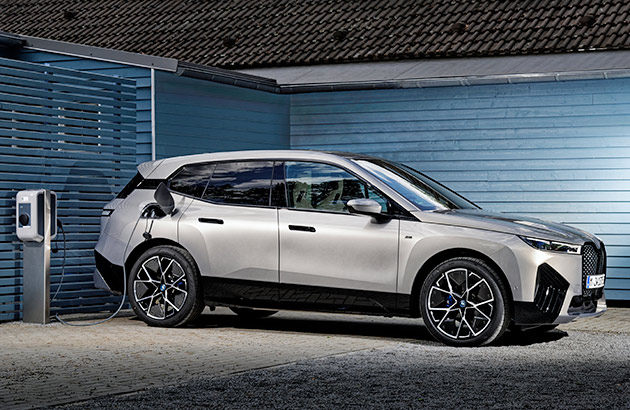
If the BMW iX really represents the future, then we’re here for it.
Currently available in three models – 270kW xDrive40, 370kW xDrive50 and 455kW M60 – the large SUV is the Bavarian brand’s electrified SUV flagship for now.
Ushering in BMW’s fifth-generation eDrive drivetrain with an electric motor on each axle and aided by excellent aerodynamics, the iX is quick by any standards.
The 40 is fitted with a big 77kWh battery, while the 50 and M60 boast a mammoth 111kWh battery.
A 50kW DC public fast charger will take the 50’s battery from 10 to 80 per cent in 95 minutes. Otherwise, it’s about 17 hours using an optional 7kW Wallbox at home/work respectively, to avoid nearly two days plugged into a regular wall socket – yes, two days. The 40’s times should be about 40 per cent shorter.
The iX employs a lightweight aluminium spaceframe and a carbon-fibre ‘safety cage’, assisting efficiency whilst making it ultra-strong. The optional air suspension also brings an amazingly soft ride. To maximise cabin space, the iX banishes the central transmission tunnel.
BMW is at the top of the EV game.
| Motor: | Synchronous electric permanent-magnet |
|---|---|
| Transmission/drive: | Single-speed reduction gear/AWD |
| Battery: | 77kWh or 111kWh Lithium Ion |
| Power/torque: | 240kW/630Nm, 385kW/765Nm, 455kW/1100Nm |
| 0-100km/h: | 6.1, 4.6, 3.8s |
| Consumption: | 20.3, 20.8, 21.7kWh/100km |
| Electric range: | 425, 630, 566km |
| Warranty: | 5yr/unlimited km |
| Battery warranty: | 8yr/160,000km |
| Safety rating: | 5 stars |
Jaguar I-Pace from $144,125
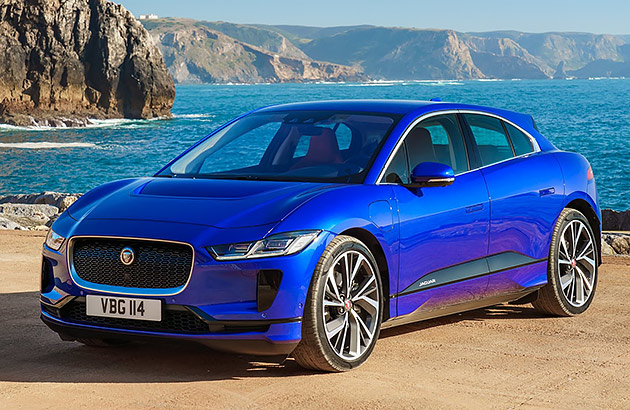
If the I-Pace cannot shake Jaguar’s pipes-and-slippers reputation, nothing can.
A bolt from the blue, the Austrian-built I-Pace is a sleek five-seater crossover sitting on a dedicated EV platform.
Its family-orientated SUV packaging results in ample space for five adults, sumptuous seating and a massive boot beneath, while the high-tech, elegantly-styled dash features intuitive controls, tactile materials and plenty of storage.
In 2023 a raft of minor updates and improvements were introduced.
With an electric motor at each end driving all four wheels, acceleration is startling, accompanied by a turbine whoosh. With AWD, carving up corners quickly and securely is another I-Pace strength, emphasising the Jaguar’s high-speed balance and control.
The 90kWh battery pack needs 44 hours using a normal home socket or nearly 14 hours using an optional 7kW Wallbox at home/work. Otherwise, a 50kW DC public fast charger requires just 75 minutes for a 10 to 80 per cent top-up.
| Motor: | Synchronous electric permanent-magnet |
|---|---|
| Transmission/drive: | Single-speed reduction gear/AWD |
| Battery: | 90kWh Lithium Ion |
| Power/torque: | 294kW/696Nm |
| 0-100km/h: | 4.8s |
| Consumption: | 22kWh/100km |
| Electric range: | 446km |
| Warranty: | 5yr/unlimited km |
| Battery warranty: | 8yr/160,000km |
| Safety rating: | 5 stars |
Audi Q8 e-tron from $153,984
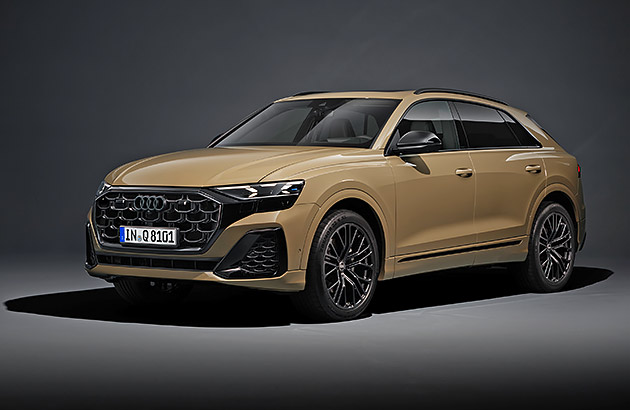
The Q8 e-tron is a facelift of the e-tron SUV, and again comes in roomy SUV wagon or swoopy Sportback ‘coupe’ choices.
Keep in mind that the e-tron wears different clothes to the petrol/diesel Q8 models, though they all ride on the same adaptable architecture.
Along with a new badge, the makeover includes different lights and grille, improved aerodynamics, an updated interior and a massive battery size upgrade.
Being a quattro in Audi-speak means all-wheel drive, with an electric motor on each axle. The SQ8 flagship has three motors, to deliver 210km/h performance.
Using a 50kW DC charger, that big battery reaches 80 per cent in about 100 minutes, or 17 hours with a 7kW garage Wallbox. A home socket might need up to 55hrs for a full refill.
Dating back to the end of last decade, the Q8 line is now one of the older SUV EVs available.
Rivals include the BMW iX and Mercedes EQC.
| Motor: | Synchronous electric permanent-magnet |
|---|---|
| Transmission/drive: | Single-speed reduction gear/AWD |
| Battery: | 95kWh, 114kWh Lithium Ion |
| Power/torque: | 300kW/664Nm, 370kW/973Nm |
| 0-100km/h: | 5.6s / 4.5s |
| Consumption: | 20.6, 23.8kWh/100km |
| Electric range: | 582km, 499km |
| Warranty: | 5yr/unlimited km |
| Battery warranty: | 8yr/160,000km |
| Safety rating: | 5 stars |
Mercedes-Benz EQS SUV from $210,000 drive-away*
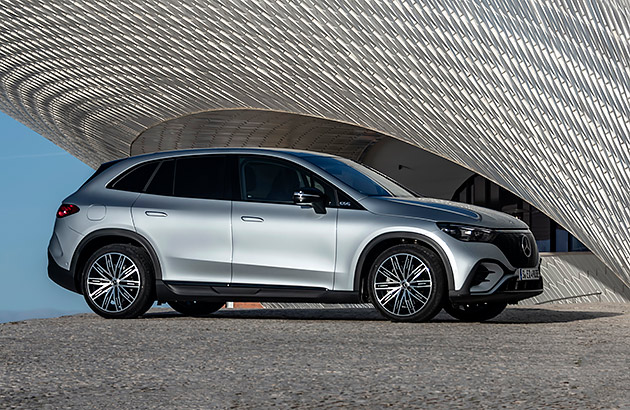
The high-riding EQS SUV is a five-seater ultra-luxury EV crossover targeting consumers who would have bought the now-discontinued (in Australia) Tesla Model X.
At over 5.1 metres long and nearly two metres wide, there’s space for passengers to luxuriate in opulence, while surrounded by the brand’s available ‘Hyperscreen’ display wall, 360-degree surround-sound audio and cutting-edge safety.
Airline-style reclining rear seats are another drawcard, highlighting the limousine aspect of the Mercedes flagship EV SUV – if you ignore the Maybach version.
Underneath, the EQS SUV boasts the sophisticated EVA electrical architecture.
The EQS450 4Matic has a motor on each axle for all-wheel drive. Dubbed 4Matic, it also includes an off-road mode.
The 125kWh battery’s massive size means you’ll need nearly 60 hours to fully charge it using a regular home outlet; a 7kW Wallbox slashes that to about 18 hours, while a 50kW DC public charger requires around 105 minutes to go from 10 to 80 per cent.
| Motor: | Synchronous electric permanent-magnet |
|---|---|
| Transmission/drive: | Single-speed reduction gear/AWD |
| Battery: | 125kWh Lithium Ion |
| Power/torque: | 265kW/800Nm |
| 0-100km/h: | 6.1s |
| Consumption: | 20.0kWh/100km |
| Electric range: | 531km |
| Warranty: | 5yr/unlimited km |
| Battery warranty: | 10yr/250,000km |
| Safety rating: | 5 stars |
Lotus Eletre from $189,990
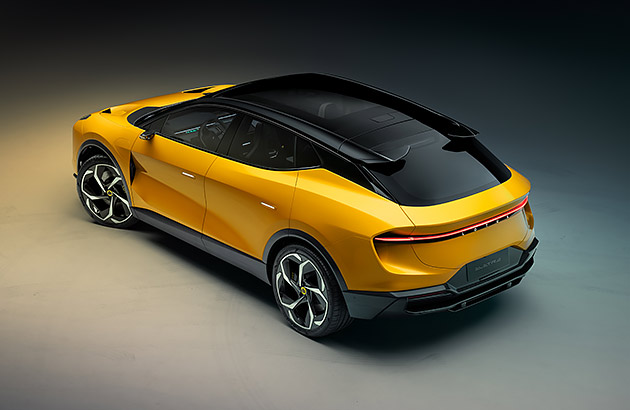
UK-designed and built in China, Geely-owned Lotus’ Eletre is the sports carmaker’s first SUV. And they’ve made it a memorable one. Three grades are available.
Boasting 675kW and 260km/h, the flagship R grade from is one of history’s most powerful production cars, yet it can also manage 490km in a single charge.
Traditionalists might rage over a five-metres long, 2.7-tonne and five-seater Lotus SUV, but the minimalistic symmetry of the giant interior pays lip service to the brand’s founder’s “Add lightness” mantra.
It’s also very techy, with an 800V all-electric architecture and high-speed charging capabilities, while the R features active suspension and rear-wheel steering for razor-sharp cornering.
The huge 112kWh battery needs 56 hours to brim plugged in at home, or just 18hrs with that 7kW Wallbox; a 50kW DC charger can do it to 80 per cent in less than 100 minutes.
Ferociously fast and yet family-friendly, the highly-unique Eletre is the EV SUV that Lamborghini hasn’t yet built.
| Motor: | Synchronous electric permanent-magnet |
|---|---|
| Transmission/drive: | 1-speed reduction gear/AWD (R: 2-speeds) |
| Battery: | 112kWh Lithium Ion |
| Power/torque: | 450kW/710Nm (R: 675kW/985Nm) |
| 0-100km/h: | 4.5s (R: 2.9s) |
| Consumption: | 21.4kWh/100km (R: 24.2 kWh/100km) |
| Electric range: | 600km (R: 489km) |
| Warranty: | 5yr/unlimited km |
| Battery warranty: | 8yr/160,000km |
| Safety rating: | N/A |
* Drive-away price is for WA only.
Electric range is quoted using the World harmonised Light vehicle Testing Procedure (WLTP), or otherwise are manufacturers’ claims.
Members save 10% on RAC's Home EV chargers
Faster, smarter, convenient - power your EV at home with our 7.4kW and 22kW chargers. Includes full installation and an app for easy scheduling.
